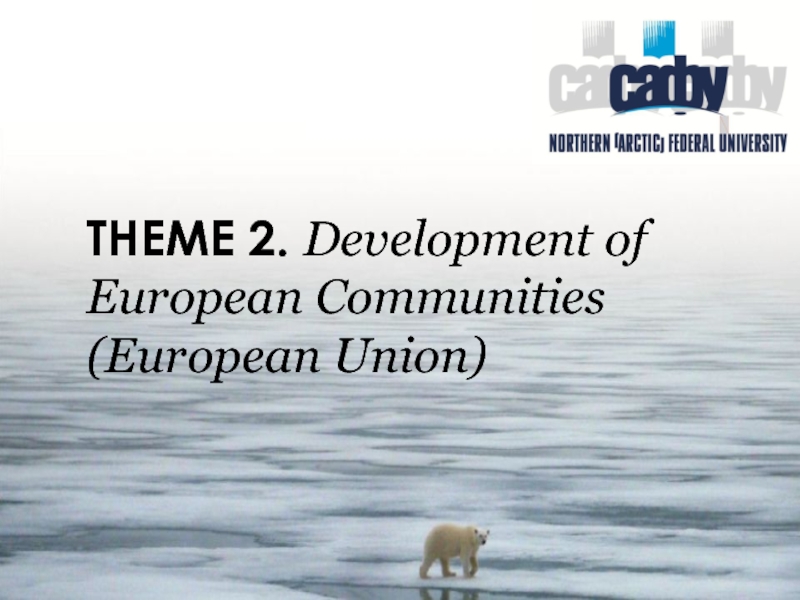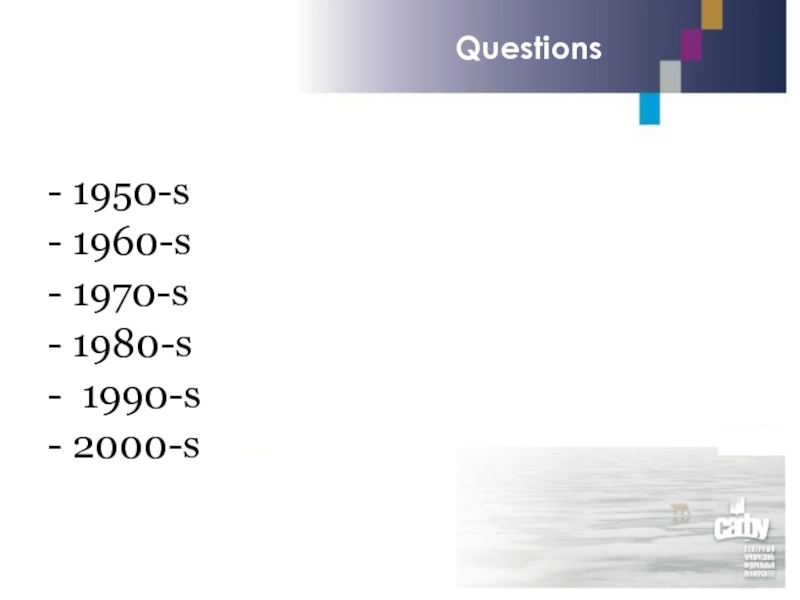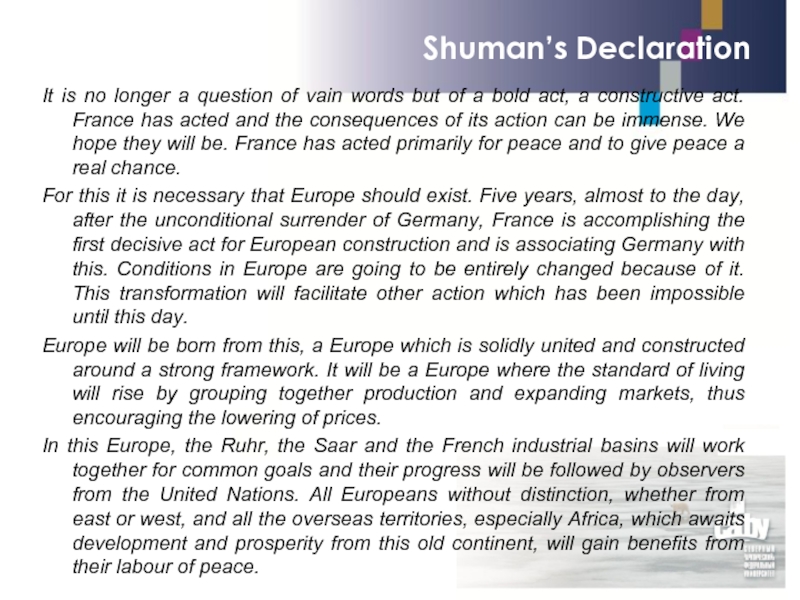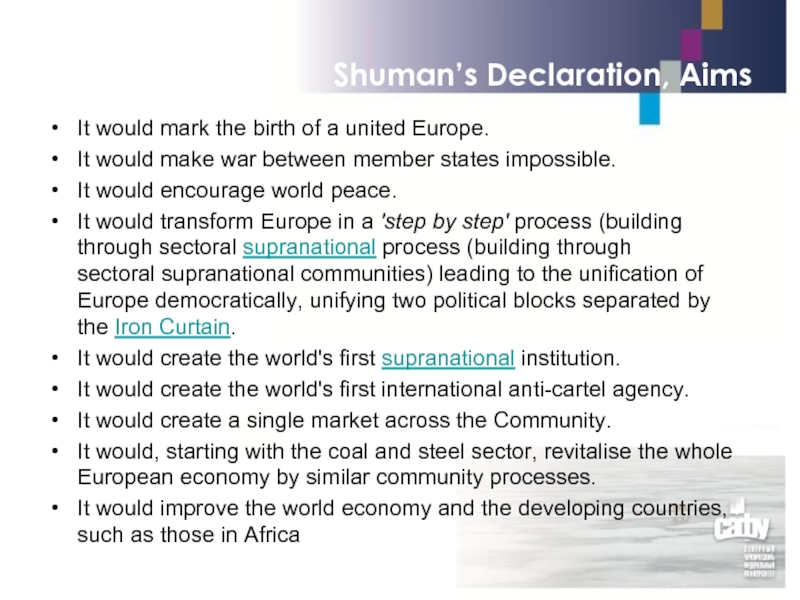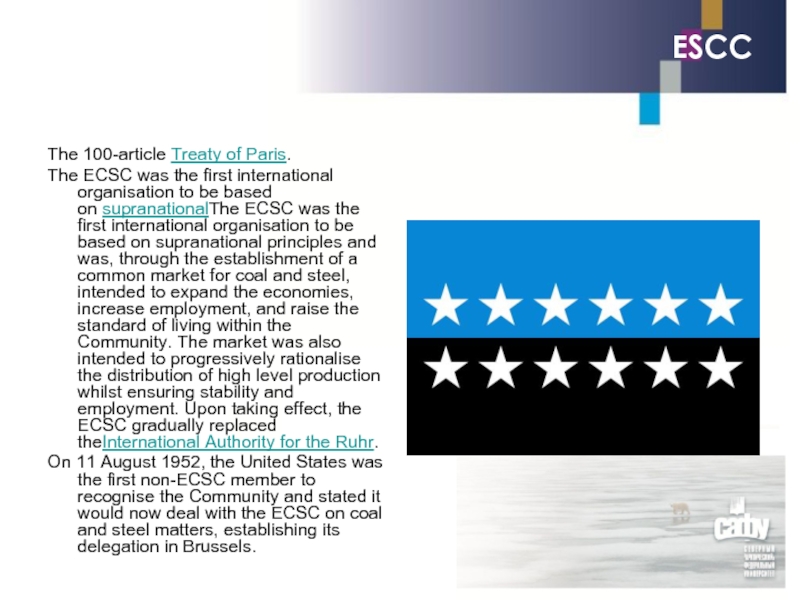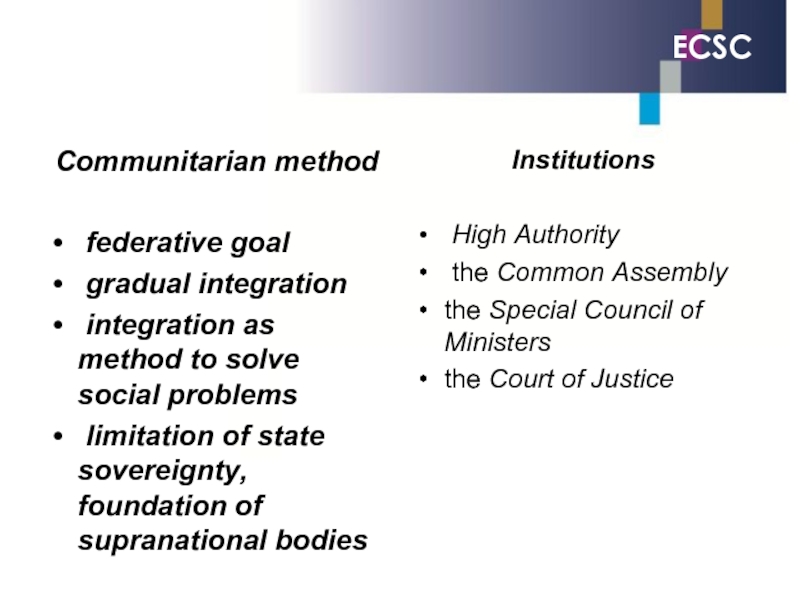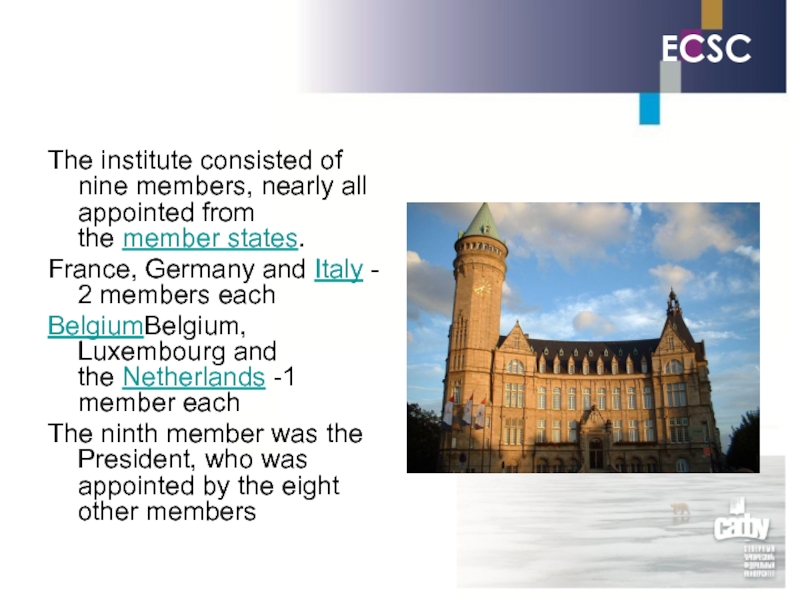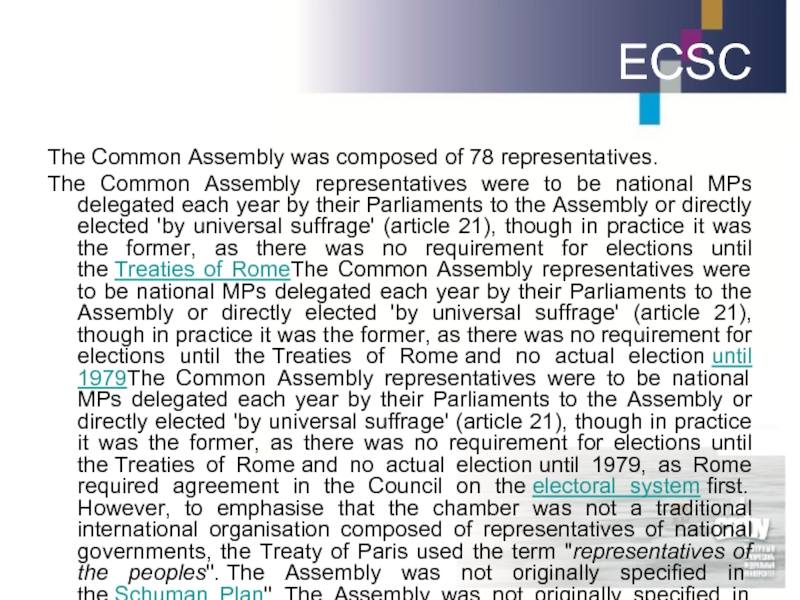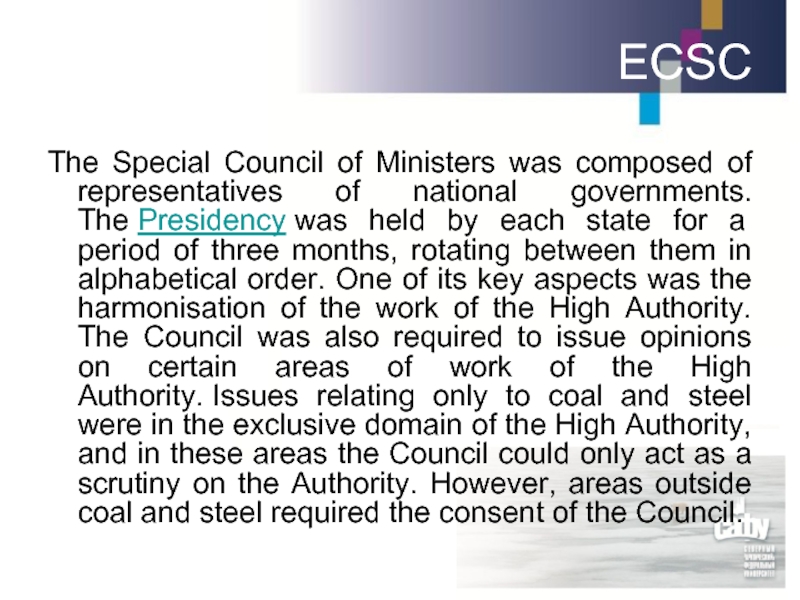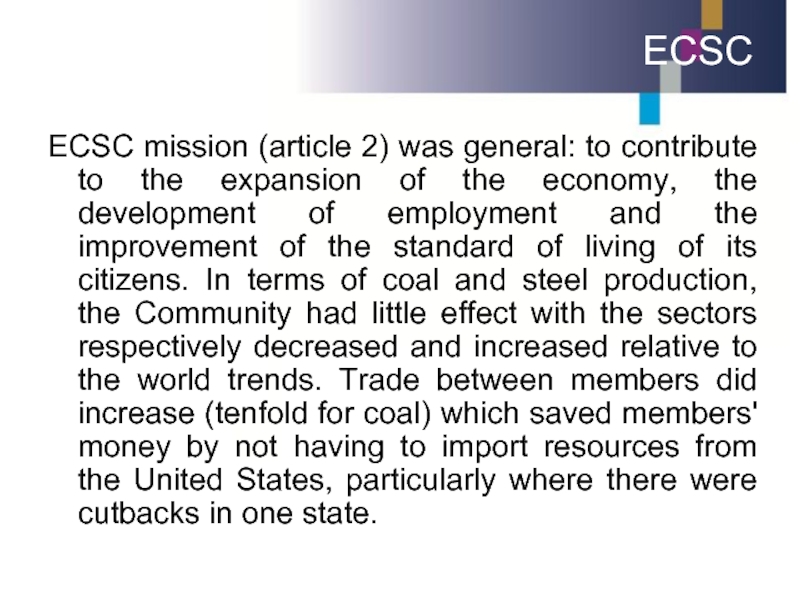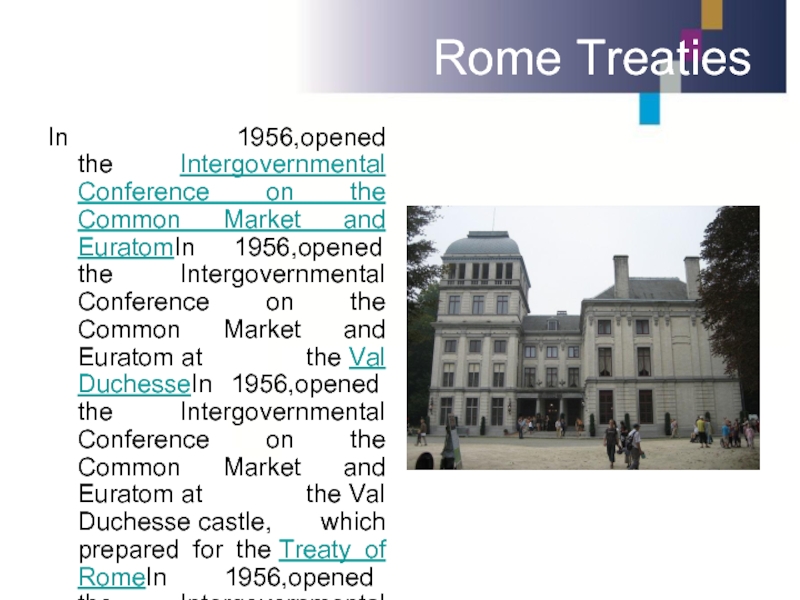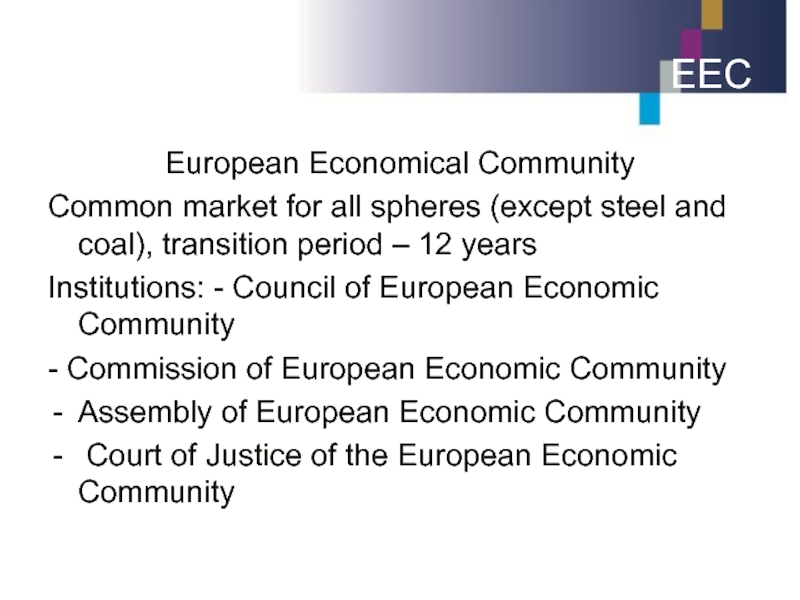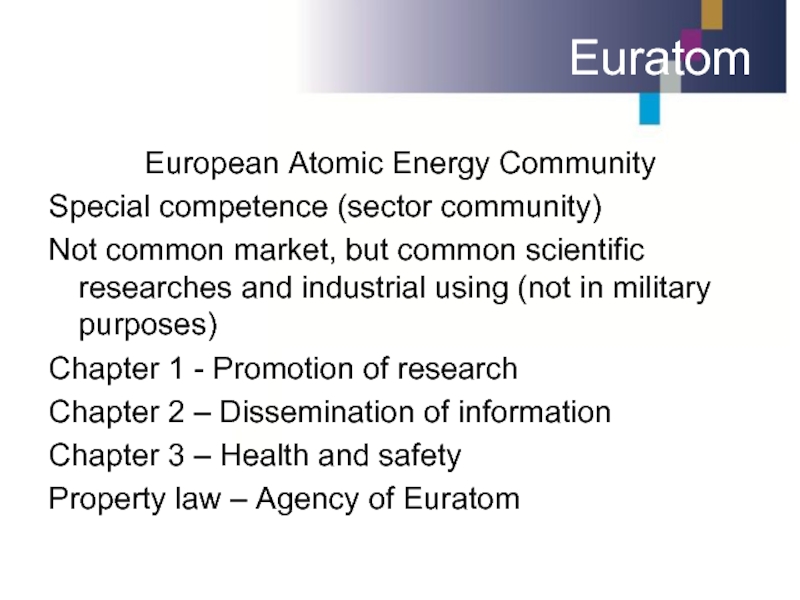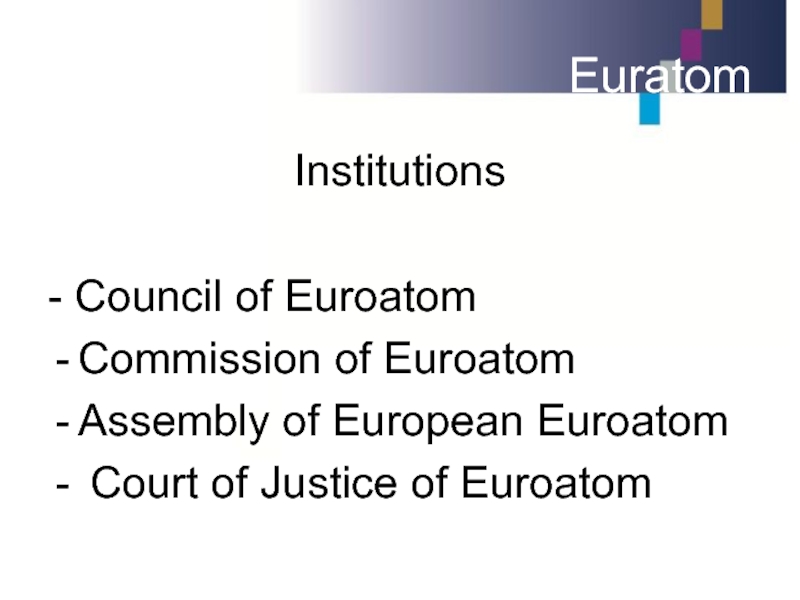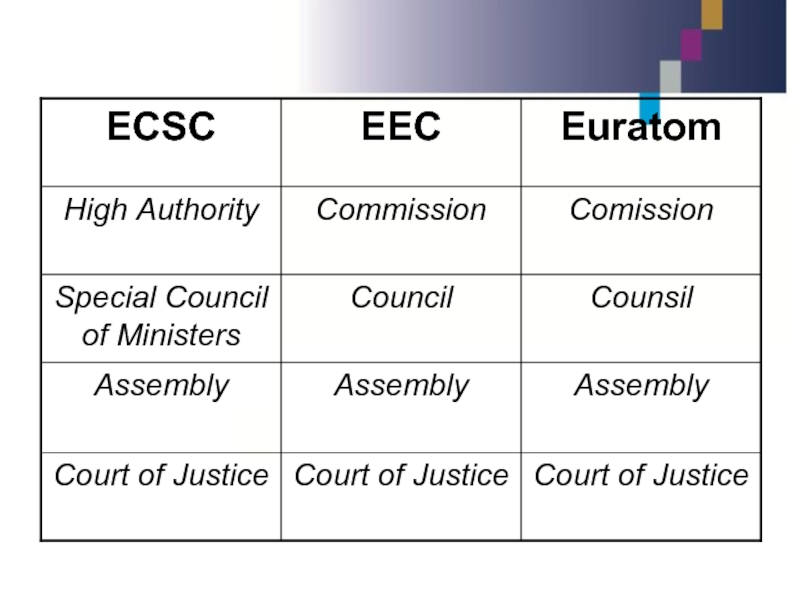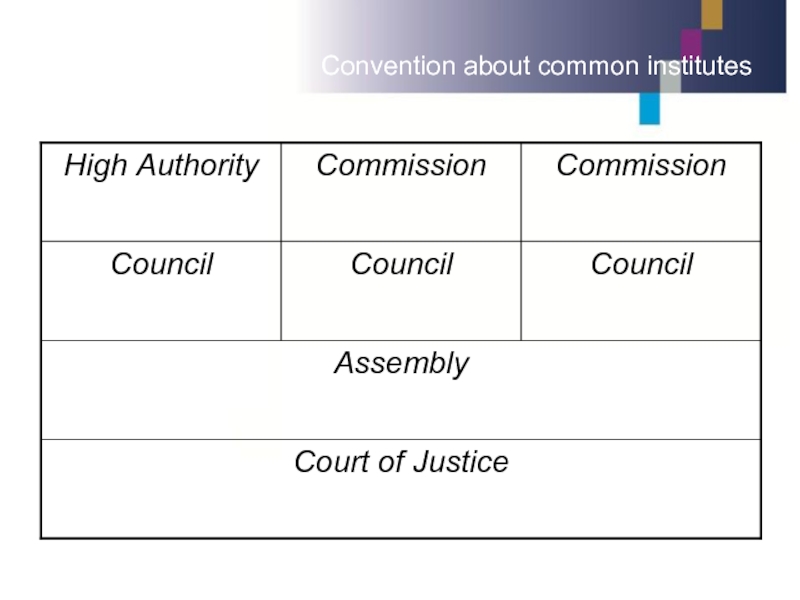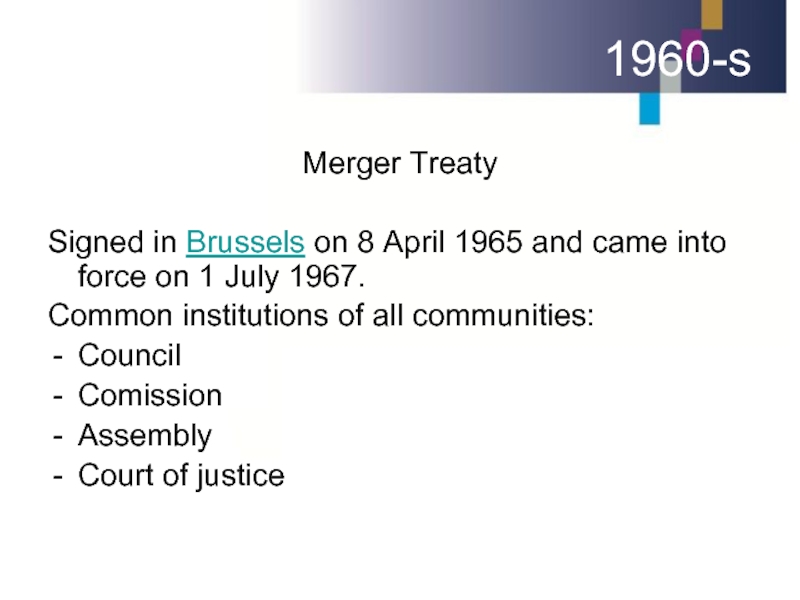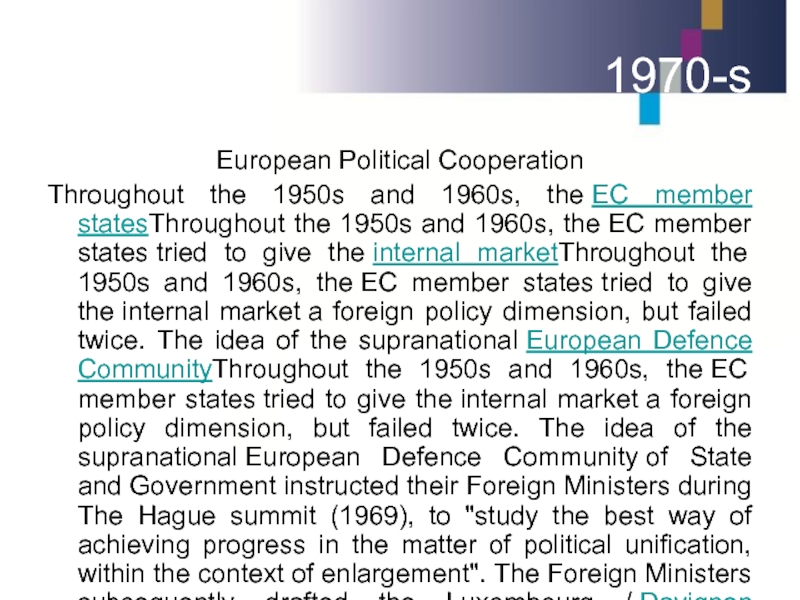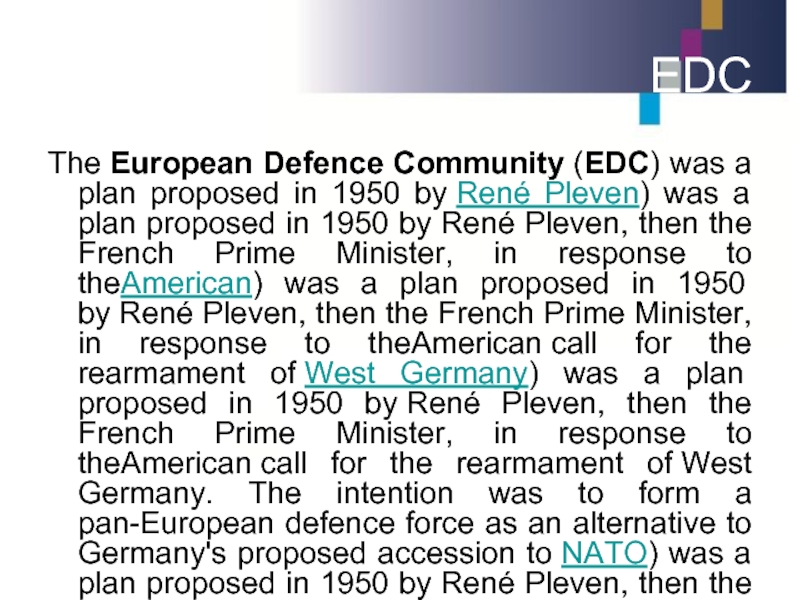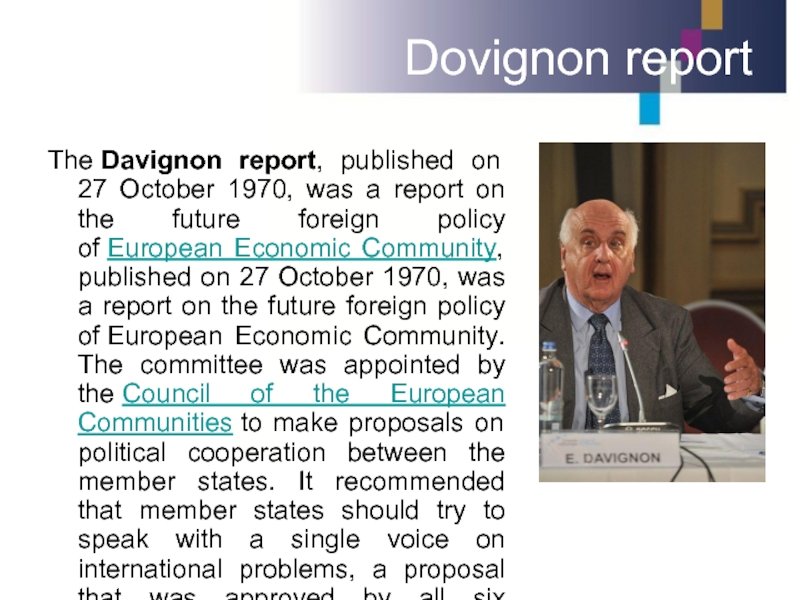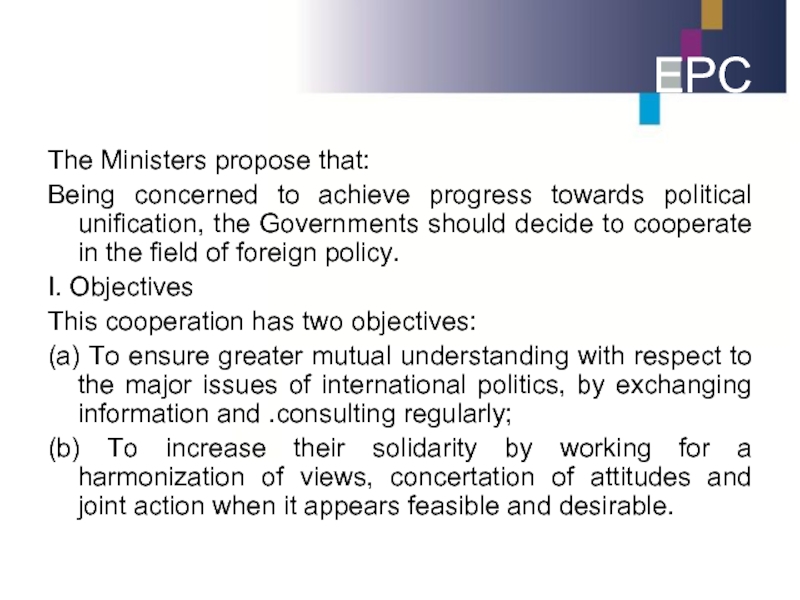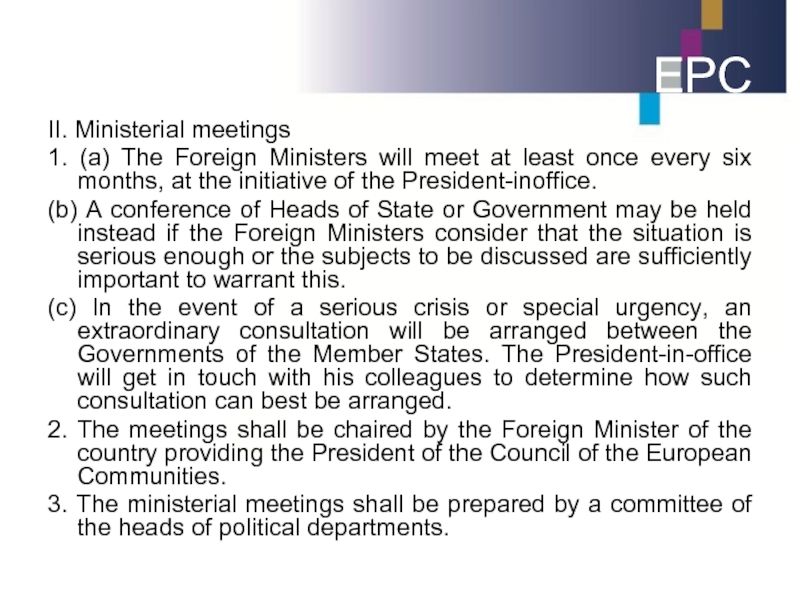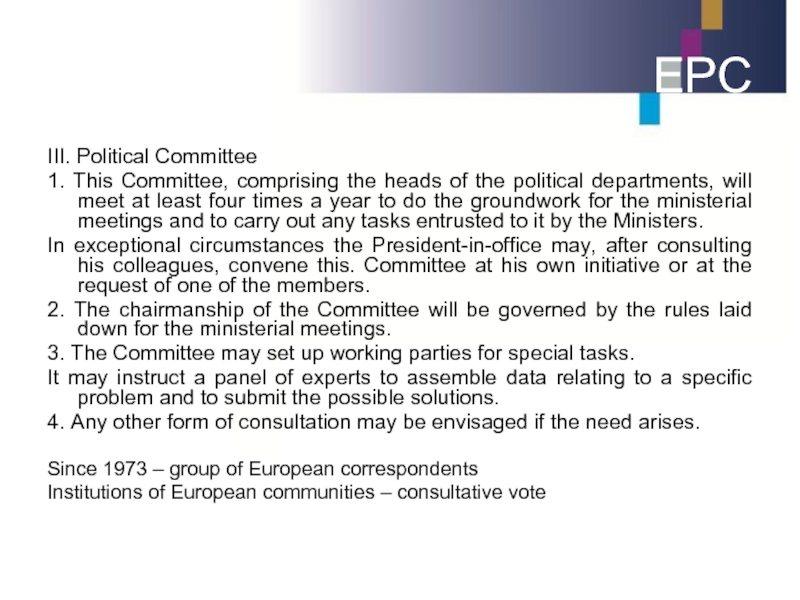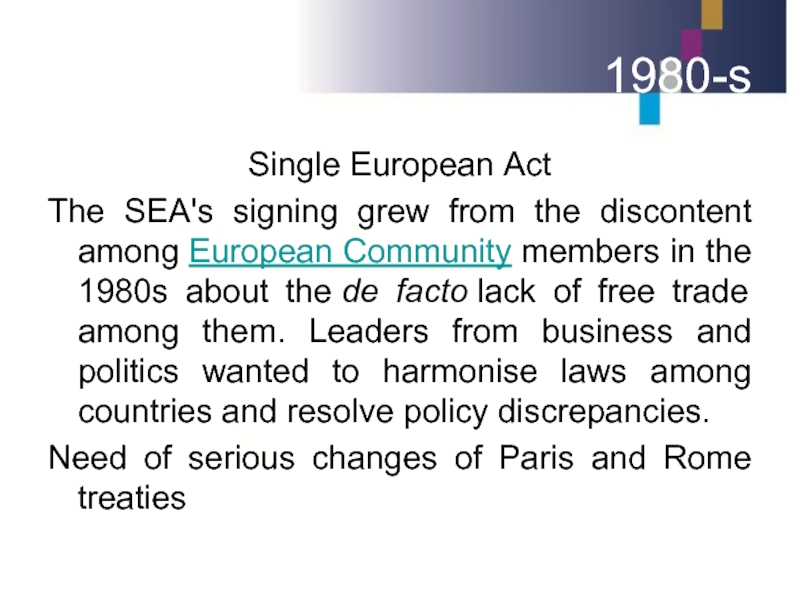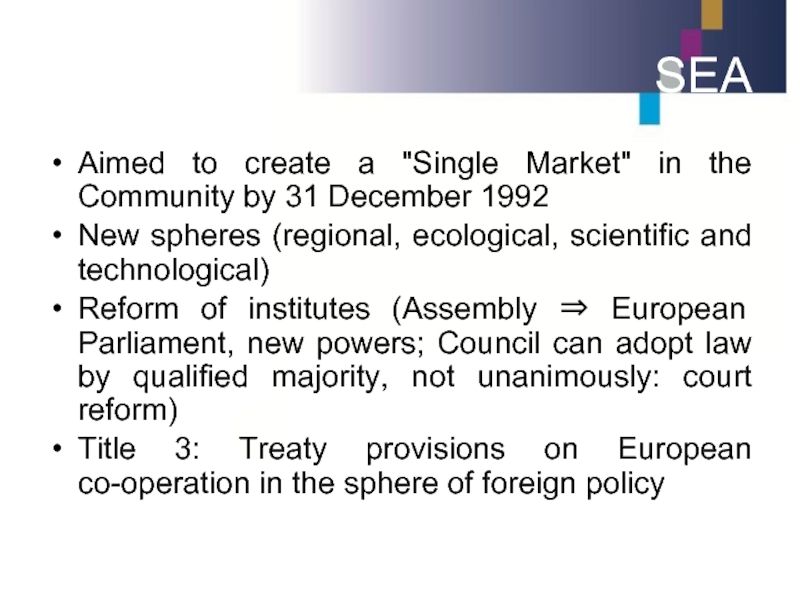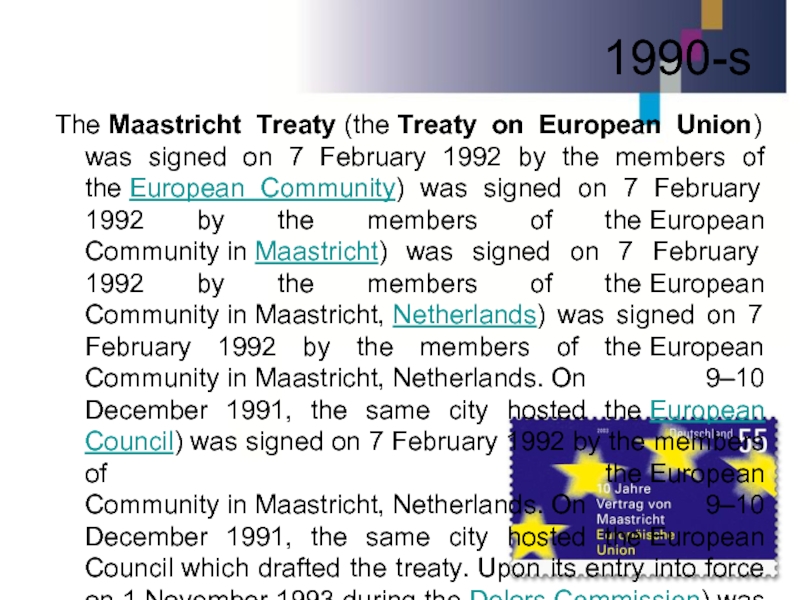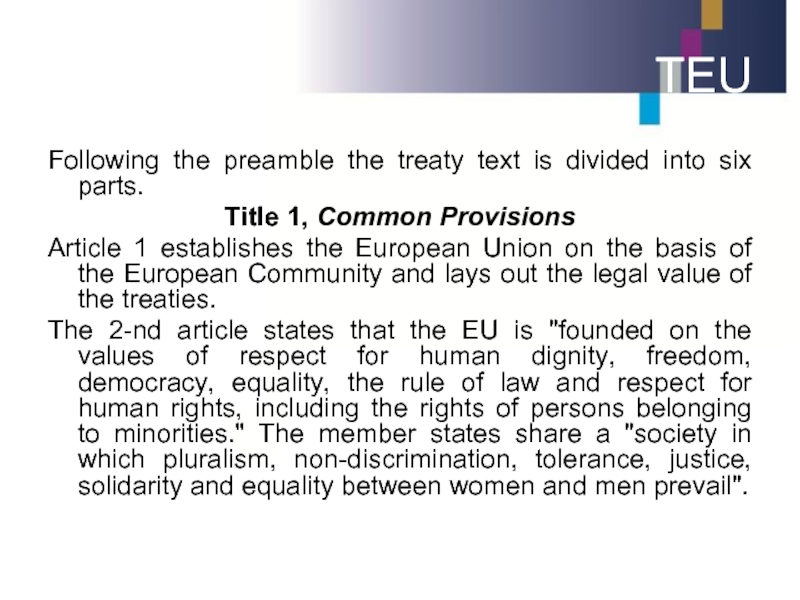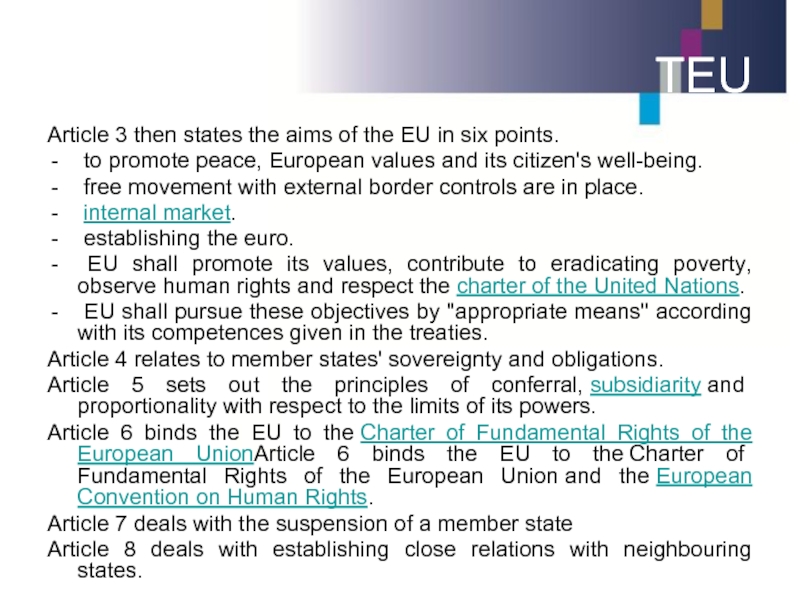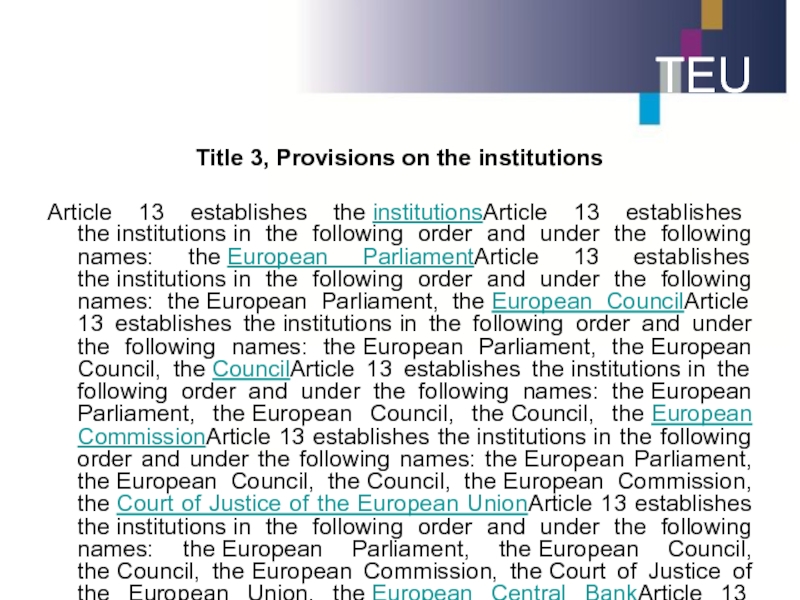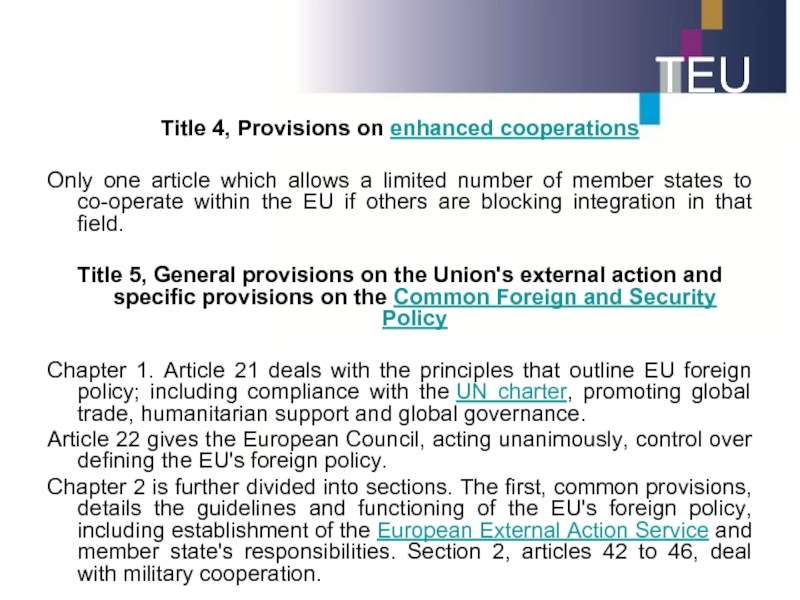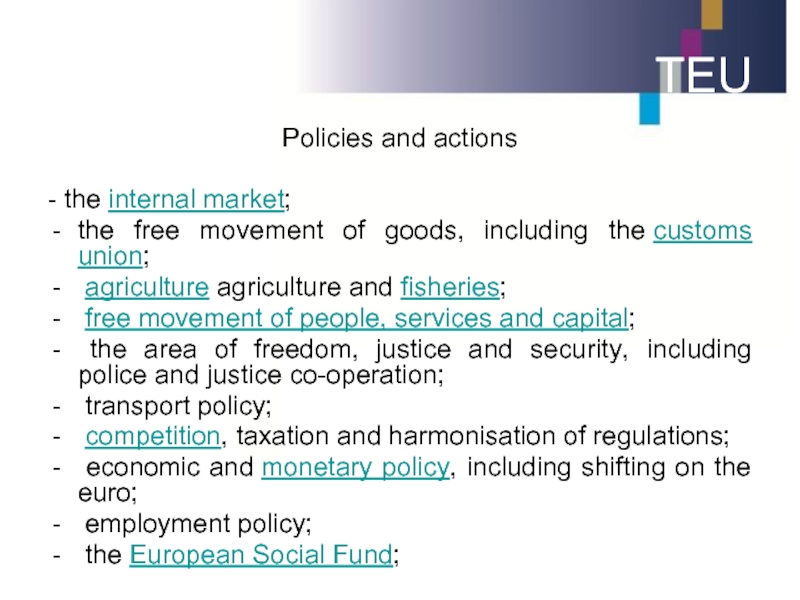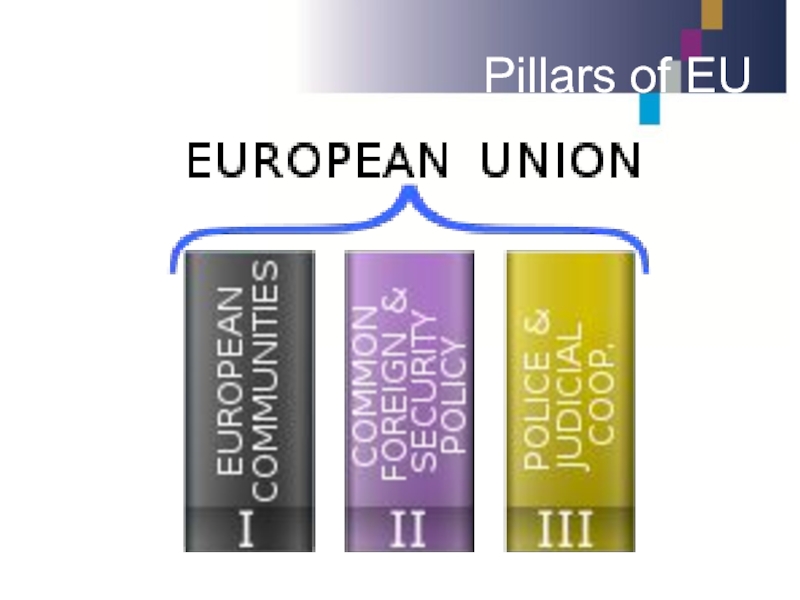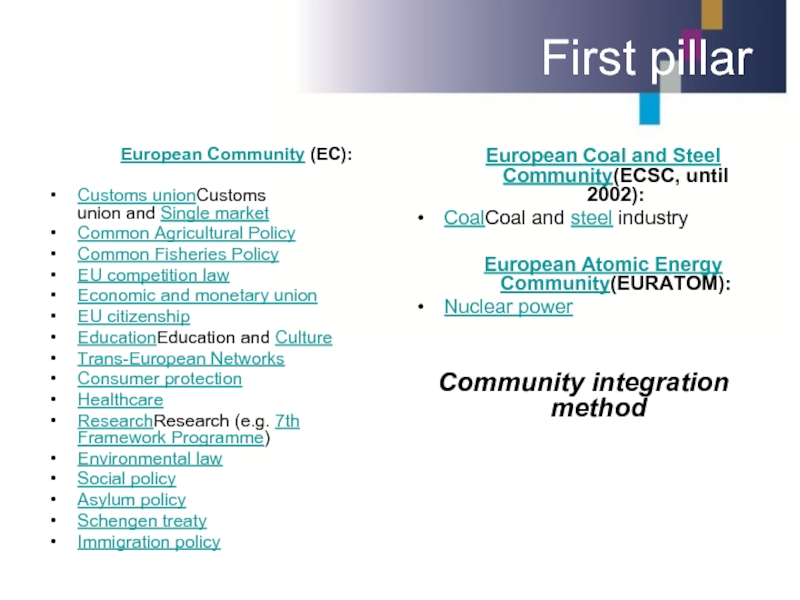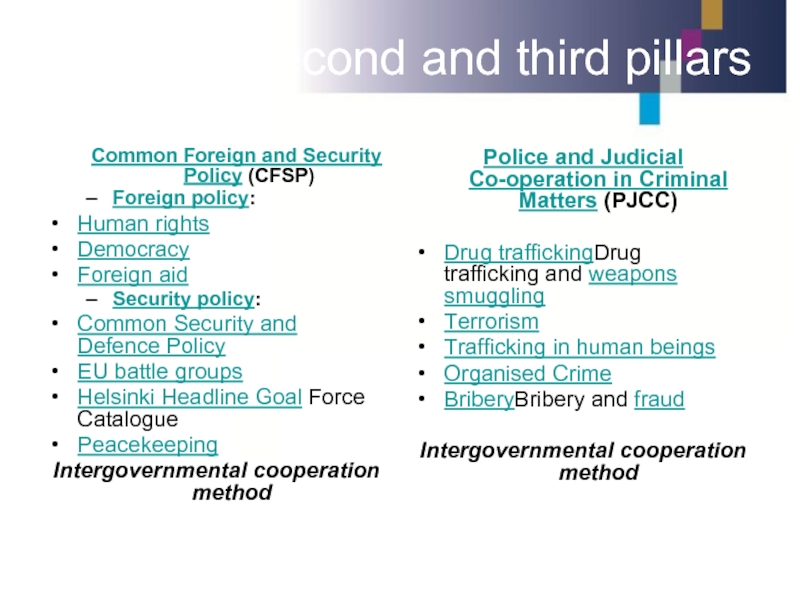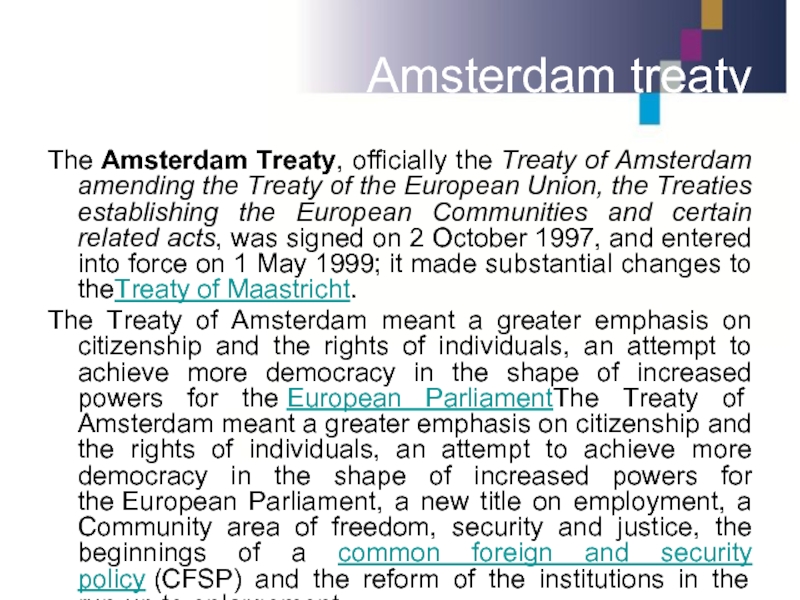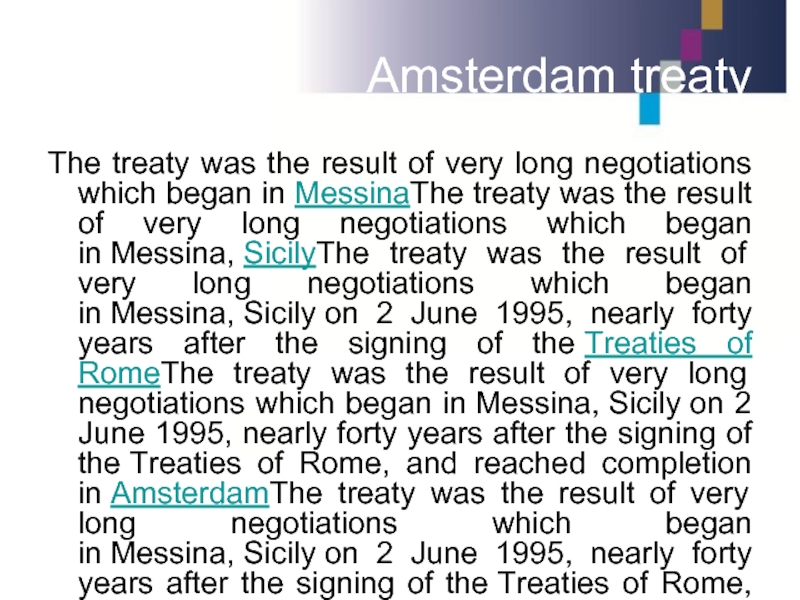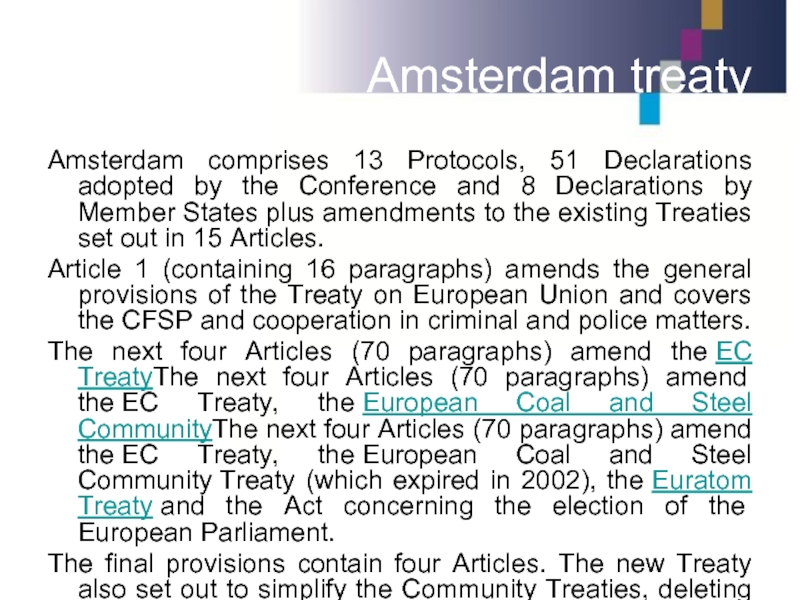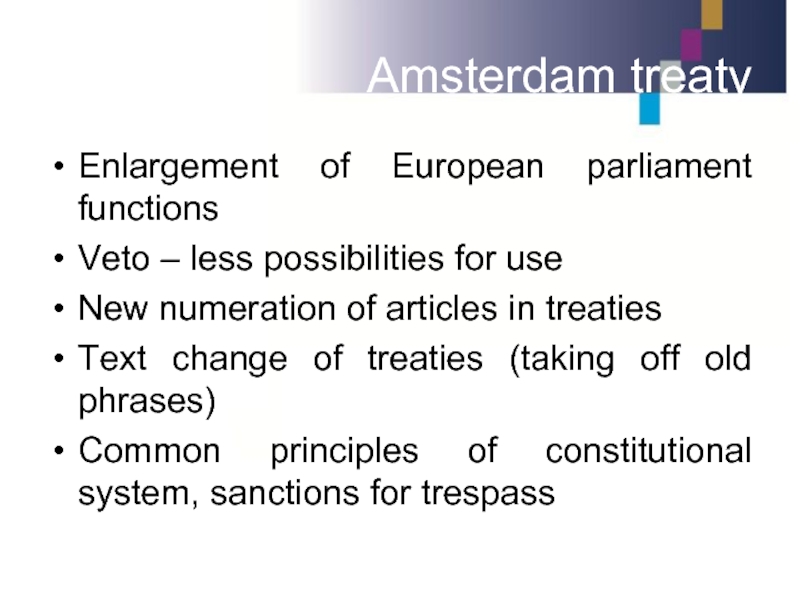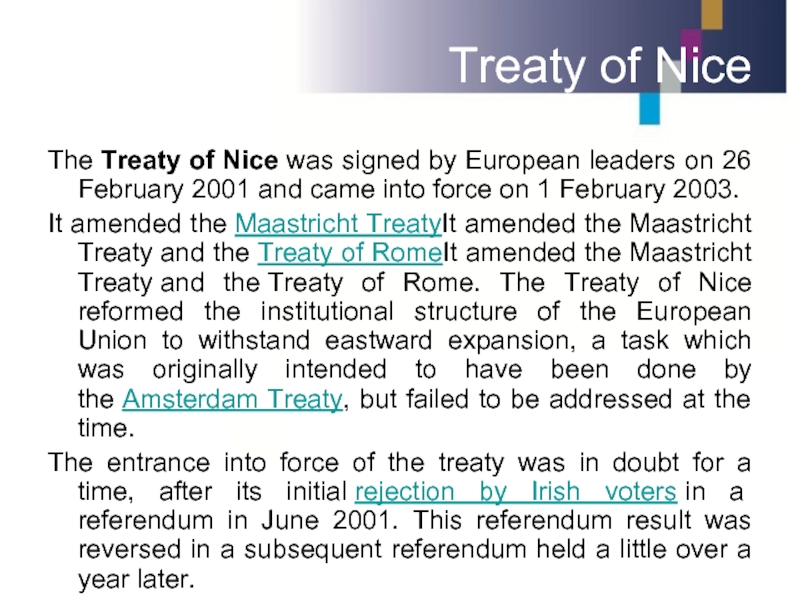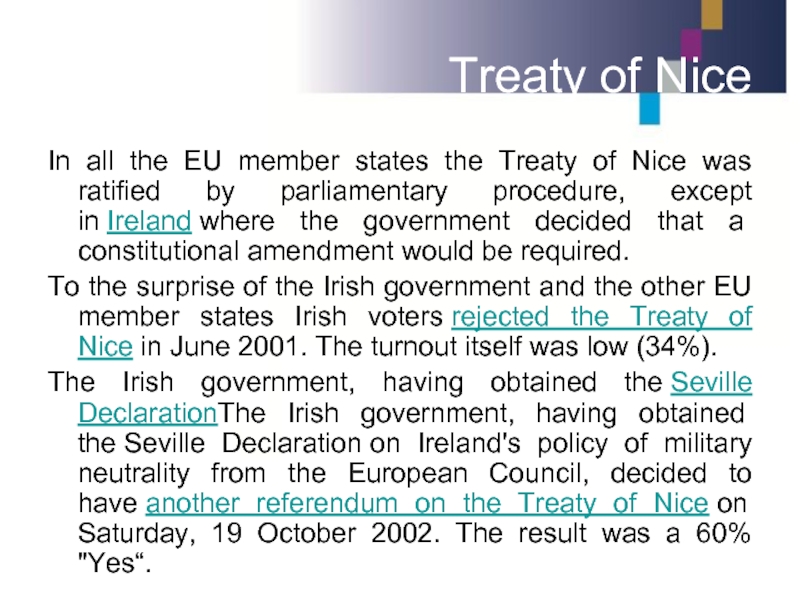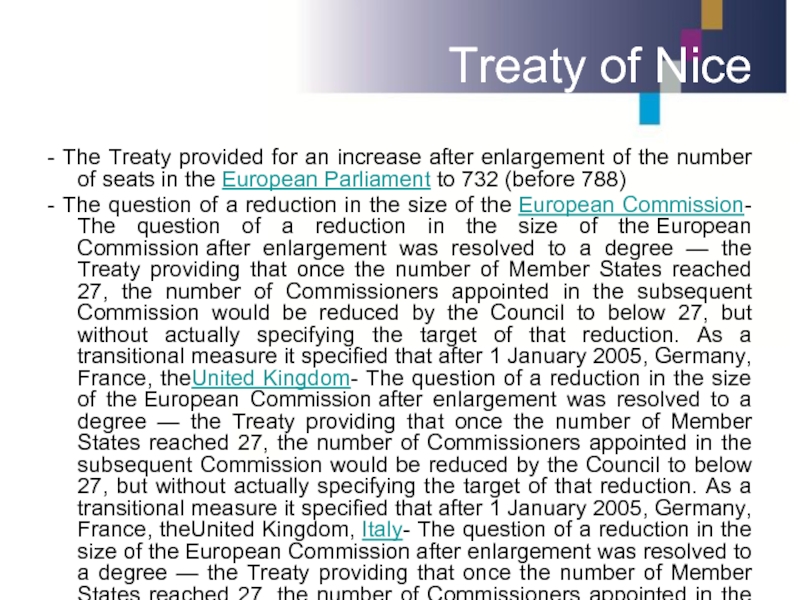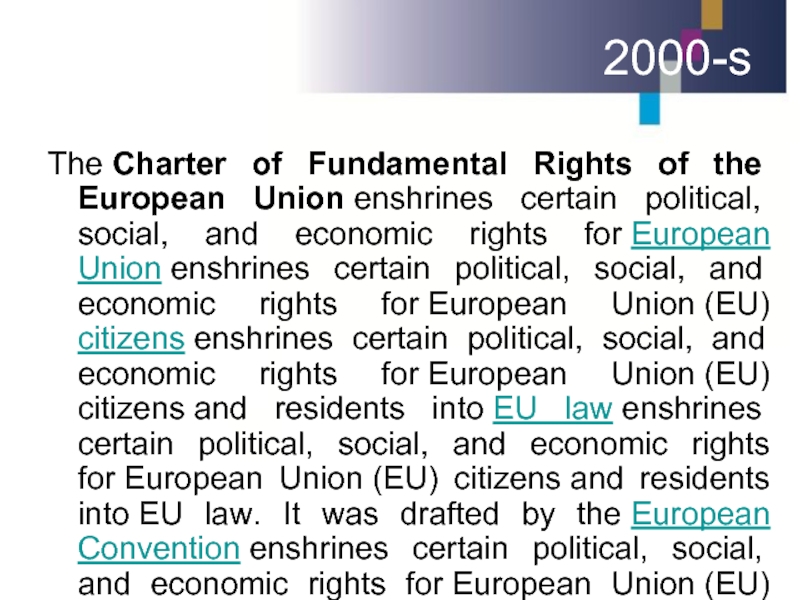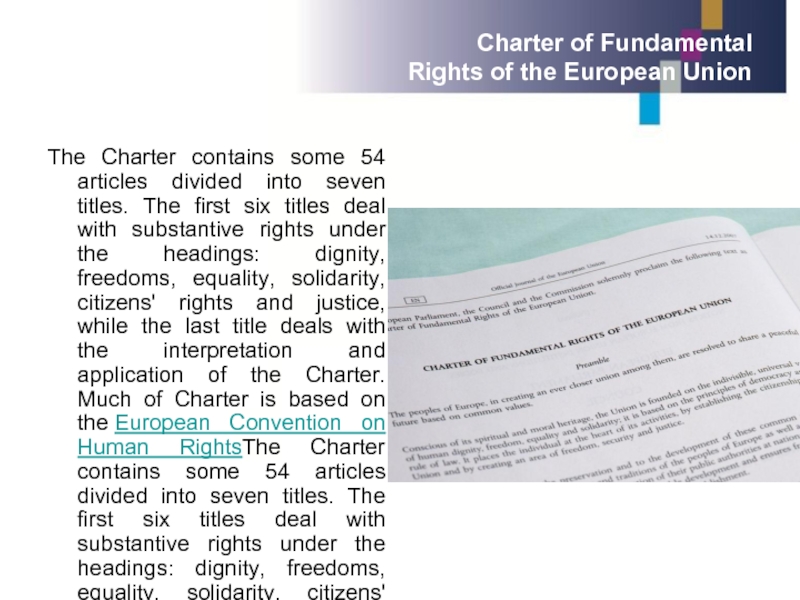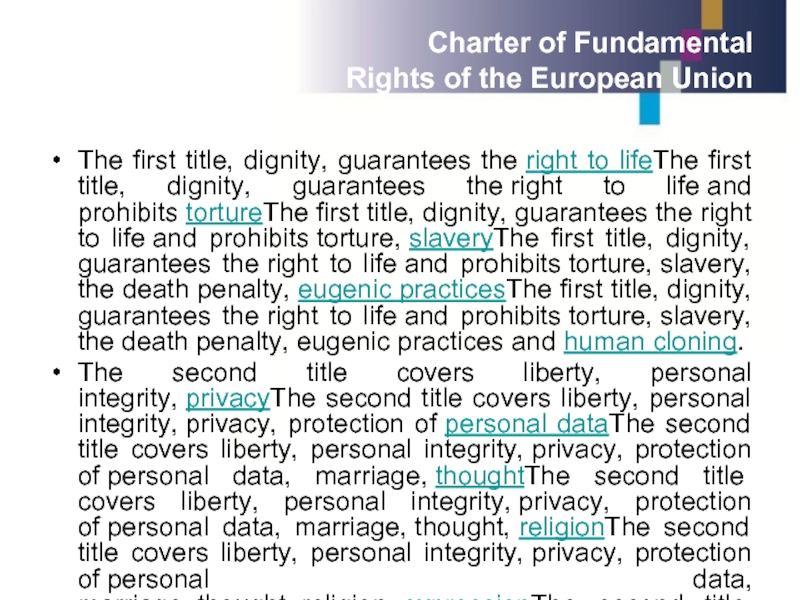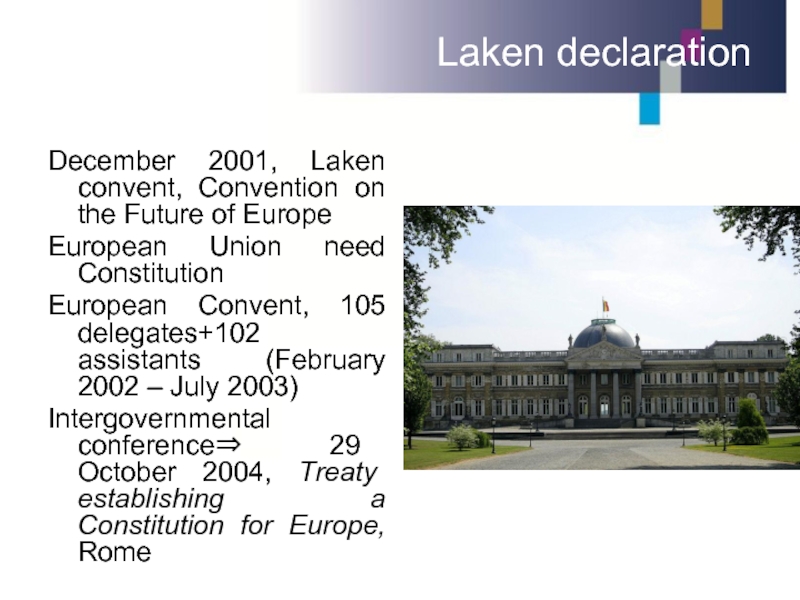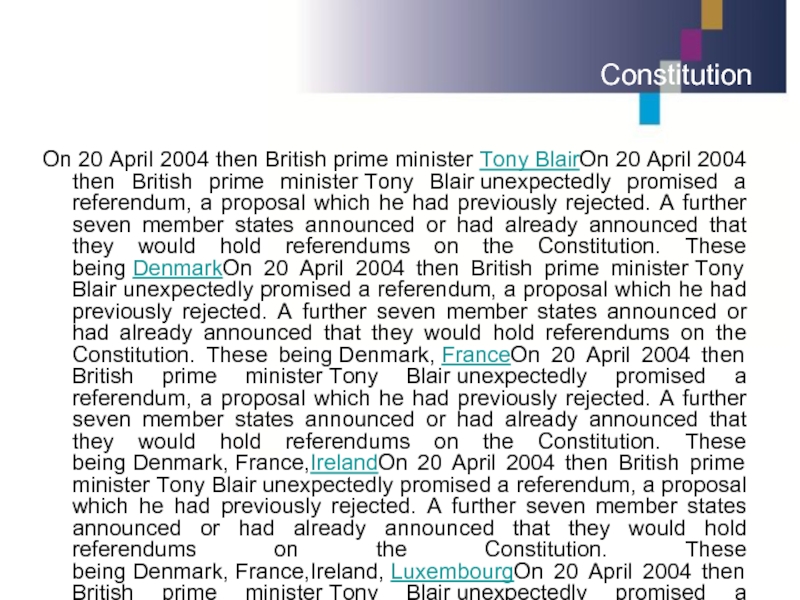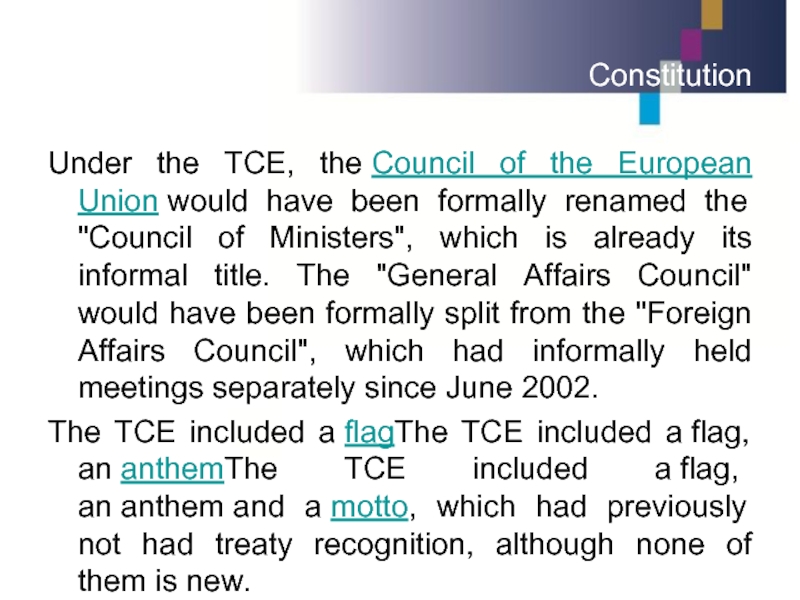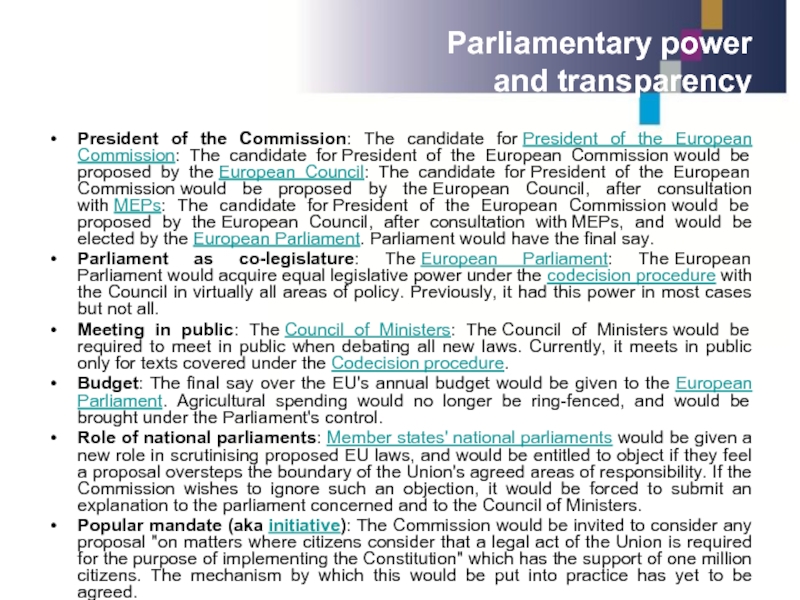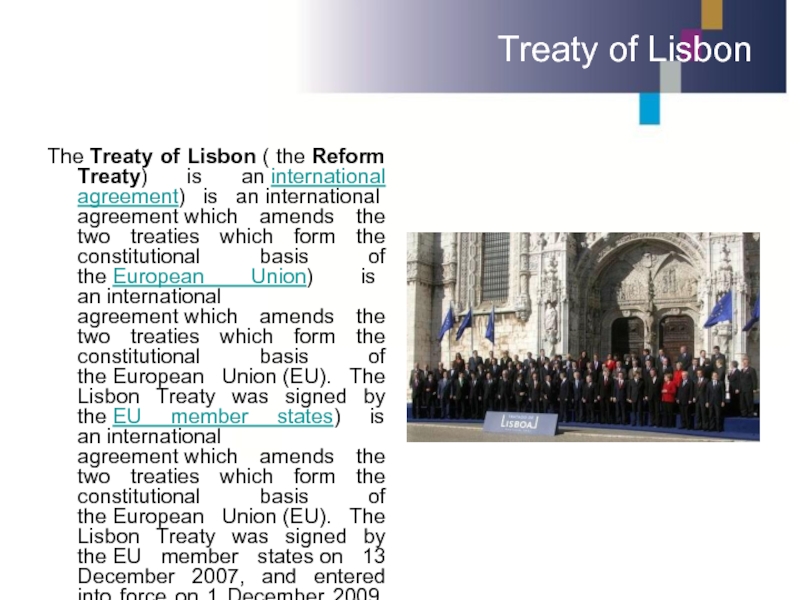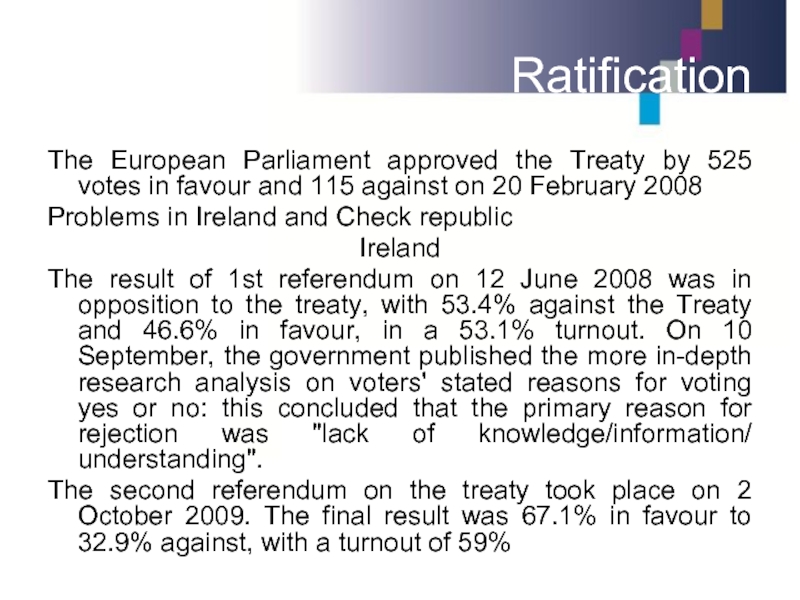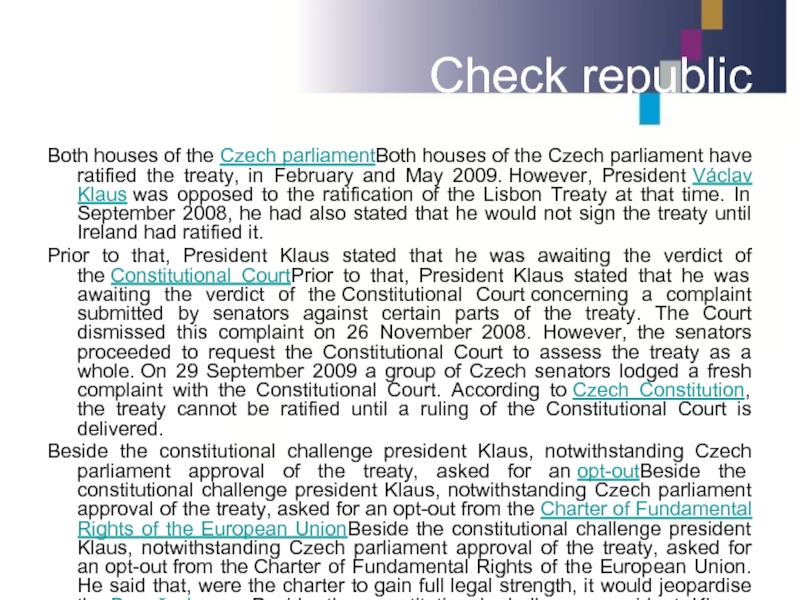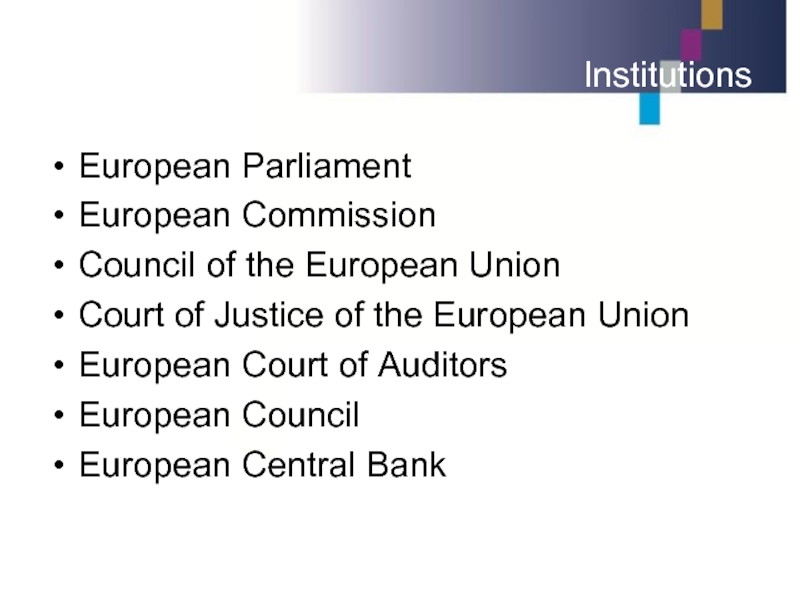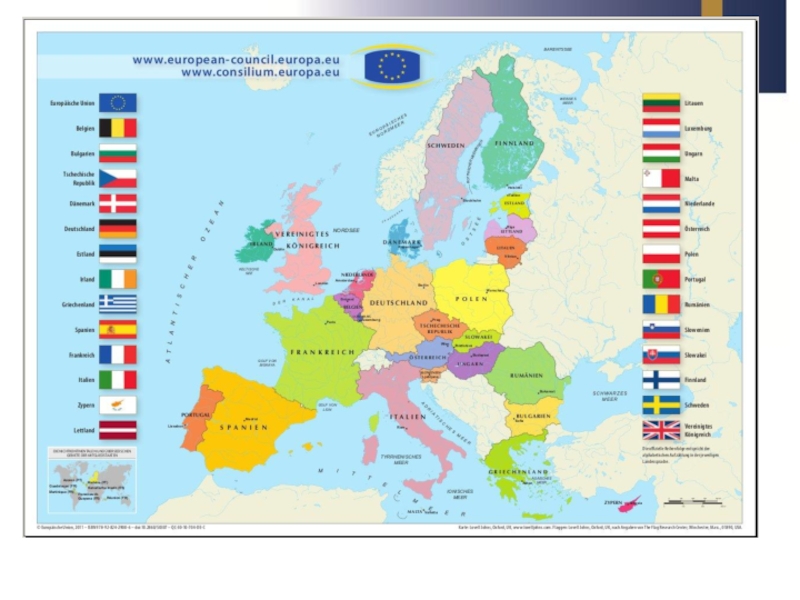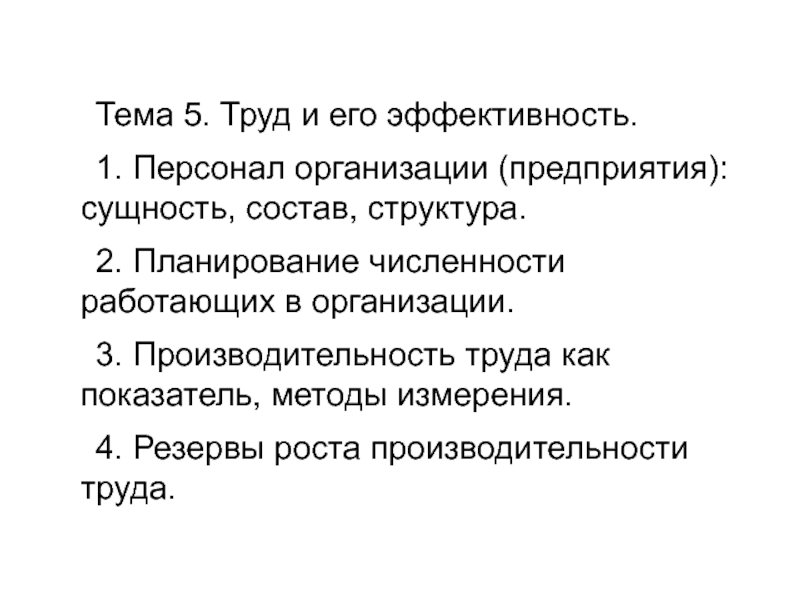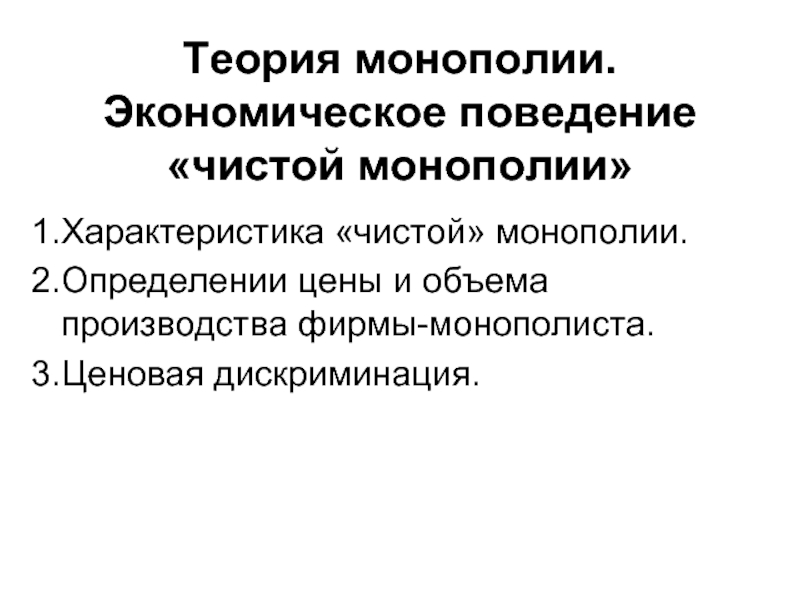- Главная
- Разное
- Дизайн
- Бизнес и предпринимательство
- Аналитика
- Образование
- Развлечения
- Красота и здоровье
- Финансы
- Государство
- Путешествия
- Спорт
- Недвижимость
- Армия
- Графика
- Культурология
- Еда и кулинария
- Лингвистика
- Английский язык
- Астрономия
- Алгебра
- Биология
- География
- Детские презентации
- Информатика
- История
- Литература
- Маркетинг
- Математика
- Медицина
- Менеджмент
- Музыка
- МХК
- Немецкий язык
- ОБЖ
- Обществознание
- Окружающий мир
- Педагогика
- Русский язык
- Технология
- Физика
- Философия
- Химия
- Шаблоны, картинки для презентаций
- Экология
- Экономика
- Юриспруденция
Development of European Communities (European Union) презентация
Содержание
- 1. Development of European Communities (European Union)
- 2. Questions 1950-s 1960-s 1970-s 1980-s 1990-s 2000-s
- 3. 1950-s Foundation of European Communities May, 9,
- 4. Schuman’s Plan
- 5. It is no longer a question of
- 6. Shuman’s Declaration, Aims It would mark the
- 7. Treaty of Paris European Coal and Steel
- 8. ESCC The 100-article Treaty of Paris. The ECSC
- 9. ECSC Communitarian method federative goal
- 10. ECSC The institute consisted of nine members,
- 11. ECSC Despite being appointed by national governments,
- 12. ECSC The Common Assembly was composed of
- 13. ECSC The Special Council of Ministers was
- 14. ECSC The Court of Justice was to
- 15. ECSC ECSC mission (article 2) was general:
- 16. Rome Treaties In 1956,opened the Intergovernmental Conference
- 17. European Economical Community Common market for all
- 18. Euratom European Atomic Energy Community Special competence
- 19. Euratom Institutions - Council of Euroatom
- 21. Convention about common institutes
- 22. 1960-s Merger Treaty Signed in Brussels on 8
- 23. 1970-s European Political Cooperation Throughout the 1950s
- 24. EDC The European Defence Community (EDC) was a plan
- 25. EPC 1969 – European leaders meeting, Hague
- 26. Dovignon report The Davignon report, published on 27
- 27. EPC The Ministers propose that: Being
- 28. EPC II. Ministerial meetings 1. (a) The
- 29. EPC III. Political Committee 1. This Committee,
- 30. 1980-s Single European Act The SEA's signing
- 31. SEA Special conference, 1986 (Greese, GBr, Denmark
- 32. SEA Aimed to create a "Single Market"
- 33. 1990-s The Maastricht Treaty (the Treaty on European Union) was
- 34. TEU 1970 – idea to create universal
- 35. TEU Following the preamble the treaty text
- 36. TEU Article 3 then states the aims
- 37. TEU Title 2, Provisions on democratic principles
- 38. TEU Title 3, Provisions on the institutions
- 39. TEU Title 4, Provisions on enhanced cooperations
- 40. TEU Title 6, Final provisions Article
- 41. TEU Policies and actions - the internal market;
- 42. TEU education, vocational training, youth and sport
- 43. Pillars of EU
- 44. First pillar European Community (EC): Customs unionCustoms
- 45. Second and third pillars Common Foreign and
- 46. Amsterdam treaty The Amsterdam Treaty, officially the Treaty of
- 47. Amsterdam treaty The treaty was the result
- 48. Amsterdam treaty Amsterdam comprises 13 Protocols, 51
- 49. Amsterdam treaty legal and personal security,
- 50. Amsterdam treaty Enlargement of European parliament functions
- 51. Treaty of Nice The Treaty of Nice was signed
- 52. Treaty of Nice In all the EU
- 53. Treaty of Nice - The Treaty provided
- 54. 2000-s The Charter of Fundamental Rights of the
- 55. The Charter contains some 54 articles divided
- 56. Charter of Fundamental Rights of the
- 57. Charter of Fundamental Rights of the
- 58. Laken declaration December 2001, Laken convent, Convention
- 59. Constitution On 12 January 2005 the European
- 60. Constitution On 20 April 2004 then British
- 61. Constitution Under the TCE, the Council of the
- 62. Constitution As stated in Articles I-1As stated in Articles
- 63. Parliamentary power and transparency President of
- 64. Treaty of Lisbon The Treaty of Lisbon ( the Reform
- 65. Ratification The European Parliament approved the Treaty
- 66. Check republic Both houses of the Czech parliamentBoth
- 67. Check republic On 2 October 2009, Ireland
- 68. Institutions European Parliament European Commission Council of
Слайд 31950-s
Foundation of European Communities
May, 9, 1950
Schuman’s plan
"Franco-German production of coal and
It would also be a first step to a "European federation".
Слайд 5It is no longer a question of vain words but of
For this it is necessary that Europe should exist. Five years, almost to the day, after the unconditional surrender of Germany, France is accomplishing the first decisive act for European construction and is associating Germany with this. Conditions in Europe are going to be entirely changed because of it. This transformation will facilitate other action which has been impossible until this day.
Europe will be born from this, a Europe which is solidly united and constructed around a strong framework. It will be a Europe where the standard of living will rise by grouping together production and expanding markets, thus encouraging the lowering of prices.
In this Europe, the Ruhr, the Saar and the French industrial basins will work together for common goals and their progress will be followed by observers from the United Nations. All Europeans without distinction, whether from east or west, and all the overseas territories, especially Africa, which awaits development and prosperity from this old continent, will gain benefits from their labour of peace.
Shuman’s Declaration
Слайд 6Shuman’s Declaration, Aims
It would mark the birth of a united Europe.
It
It would encourage world peace.
It would transform Europe in a 'step by step' process (building through sectoral supranational process (building through sectoral supranational communities) leading to the unification of Europe democratically, unifying two political blocks separated by the Iron Curtain.
It would create the world's first supranational institution.
It would create the world's first international anti-cartel agency.
It would create a single market across the Community.
It would, starting with the coal and steel sector, revitalise the whole European economy by similar community processes.
It would improve the world economy and the developing countries, such as those in Africa
Слайд 7Treaty of Paris
European Coal and Steel Community (ECSC)
Sind 18 April 1951
The common
Слайд 8ESCC
The 100-article Treaty of Paris.
The ECSC was the first international organisation to
On 11 August 1952, the United States was the first non-ECSC member to recognise the Community and stated it would now deal with the ECSC on coal and steel matters, establishing its delegation in Brussels.
Слайд 9ECSC
Communitarian method
federative goal
gradual integration
integration as method to solve
limitation of state sovereignty, foundation of supranational bodies
Institutions
High Authority
the Common Assembly
the Special Council of Ministers
the Court of Justice
Слайд 10ECSC
The institute consisted of nine members, nearly all appointed from the member
France, Germany and Italy - 2 members each
BelgiumBelgium, Luxembourg and the Netherlands -1 member each
The ninth member was the President, who was appointed by the eight other members
Слайд 11ECSC
Despite being appointed by national governments, the members were not supposed
Power
The Authority's principle innovation was its supranational character. It had a broad area of competence to ensure the objectives of the treaty were met and that the common market functioned smoothly. The High Authority could issue three types of legal instrumentsThe Authority's principle innovation was its supranational character. It had a broad area of competence to ensure the objectives of the treaty were met and that the common market functioned smoothly. The High Authority could issue three types of legal instruments: DecisionsThe Authority's principle innovation was its supranational character. It had a broad area of competence to ensure the objectives of the treaty were met and that the common market functioned smoothly. The High Authority could issue three types of legal instruments: Decisions, which were entirely binding laws;Recommendations, which had binding aims but the methods were left to member states; and Opinions, which had no legal force.
Слайд 12ECSC
The Common Assembly was composed of 78 representatives.
The Common Assembly representatives
Слайд 13ECSC
The Special Council of Ministers was composed of representatives of national
Слайд 14ECSC
The Court of Justice was to ensure the observation of ECSC
Foundation of European case law
Слайд 15ECSC
ECSC mission (article 2) was general: to contribute to the expansion
Слайд 16Rome Treaties
In 1956,opened the Intergovernmental Conference on the Common Market and
Come into force 1 January 1958
Слайд 17European Economical Community
Common market for all spheres (except steel and coal),
Institutions: - Council of European Economic Community
- Commission of European Economic Community
Assembly of European Economic Community
Court of Justice of the European Economic Community
EEC
Слайд 18Euratom
European Atomic Energy Community
Special competence (sector community)
Not common market, but common
Chapter 1 - Promotion of research
Chapter 2 – Dissemination of information
Chapter 3 – Health and safety
Property law – Agency of Euratom
Слайд 19Euratom
Institutions
- Council of Euroatom
Commission of Euroatom
Assembly of European Euroatom
Court of
Слайд 221960-s
Merger Treaty
Signed in Brussels on 8 April 1965 and came into force on
Common institutions of all communities:
Council
Comission
Assembly
Court of justice
Слайд 231970-s
European Political Cooperation
Throughout the 1950s and 1960s, the EC member statesThroughout the
Слайд 24EDC
The European Defence Community (EDC) was a plan proposed in 1950 by René Pleven)
Слайд 25EPC
1969 – European leaders meeting, Hague
Special committee “to study the best
Report by the Foreign Ministers of the Member States on the problems of political unification 27 October, 1970, Luxemburg
Слайд 26Dovignon report
The Davignon report, published on 27 October 1970, was a report
Слайд 27EPC
The Ministers propose that:
Being concerned to achieve progress towards political
I. Objectives
This cooperation has two objectives:
(a) To ensure greater mutual understanding with respect to the major issues of international politics, by exchanging information and .consulting regularly;
(b) To increase their solidarity by working for a harmonization of views, concertation of attitudes and joint action when it appears feasible and desirable.
Слайд 28EPC
II. Ministerial meetings
1. (a) The Foreign Ministers will meet at least
(b) A conference of Heads of State or Government may be held instead if the Foreign Ministers consider that the situation is serious enough or the subjects to be discussed are sufficiently important to warrant this.
(c) In the event of a serious crisis or special urgency, an extraordinary consultation will be arranged between the Governments of the Member States. The President-in-office will get in touch with his colleagues to determine how such consultation can best be arranged.
2. The meetings shall be chaired by the Foreign Minister of the country providing the President of the Council of the European Communities.
3. The ministerial meetings shall be prepared by a committee of the heads of political departments.
Слайд 29EPC
III. Political Committee
1. This Committee, comprising the heads of the political
In exceptional circumstances the President-in-office may, after consulting his colleagues, convene this. Committee at his own initiative or at the request of one of the members.
2. The chairmanship of the Committee will be governed by the rules laid down for the ministerial meetings.
3. The Committee may set up working parties for special tasks.
It may instruct a panel of experts to assemble data relating to a specific problem and to submit the possible solutions.
4. Any other form of consultation may be envisaged if the need arises.
Since 1973 – group of European correspondents
Institutions of European communities – consultative vote
Слайд 301980-s
Single European Act
The SEA's signing grew from the discontent among European Community members
Need of serious changes of Paris and Rome treaties
Слайд 31SEA
Special conference, 1986 (Greese, GBr, Denmark against).
The Danish parliament rejected the
The other nine member states signed the Single Act eleven days earlier in Luxembourg
It had been originally intended to have the SEA ratified by the end of 1986 so that it would come into force on 1 January 1987 and 11 of the then 12 member states of the EEC had ratified the treaty by that date. The deadline failed to be achieved when the Irish government were restrained from ratifying the SEA pending court proceedings.
In the court caseIn the court case, the Irish Supreme CourtIn the court case, the Irish Supreme Court ruled that the Irish ConstitutionIn the court case, the Irish Supreme Court ruled that the Irish Constitution would have to be amended before the state could ratify the treaty, something that can only be done by referendum. Such a referendum was ultimately held on 26 May 1987 when the proposal was approved by Irish voters by 69.9% in favour to 30.1% against on a turnout of 44.1%. Ireland formally ratified the Single European Act in June 1987, allowing the treaty to come into force on 1 July.
Слайд 32SEA
Aimed to create a "Single Market" in the Community by 31
New spheres (regional, ecological, scientific and technological)
Reform of institutes (Assembly ⇒ European Parliament, new powers; Council can adopt law by qualified majority, not unanimously: court reform)
Title 3: Treaty provisions on European co-operation in the sphere of foreign policy
Слайд 331990-s
The Maastricht Treaty (the Treaty on European Union) was signed on 7 February 1992
Слайд 34TEU
1970 – idea to create universal union, based on communities
Approved in
Practical stage after SEA
Constitutional reforms in member states
Слайд 35TEU
Following the preamble the treaty text is divided into six parts.
Title 1, Common
Article 1 establishes the European Union on the basis of the European Community and lays out the legal value of the treaties.
The 2-nd article states that the EU is "founded on the values of respect for human dignity, freedom, democracy, equality, the rule of law and respect for human rights, including the rights of persons belonging to minorities." The member states share a "society in which pluralism, non-discrimination, tolerance, justice, solidarity and equality between women and men prevail".
Слайд 36TEU
Article 3 then states the aims of the EU in six
to promote peace, European values and its citizen's well-being.
free movement with external border controls are in place.
internal market.
establishing the euro.
EU shall promote its values, contribute to eradicating poverty, observe human rights and respect the charter of the United Nations.
EU shall pursue these objectives by "appropriate means" according with its competences given in the treaties.
Article 4 relates to member states' sovereignty and obligations.
Article 5 sets out the principles of conferral, subsidiarity and proportionality with respect to the limits of its powers.
Article 6 binds the EU to the Charter of Fundamental Rights of the European UnionArticle 6 binds the EU to the Charter of Fundamental Rights of the European Union and the European Convention on Human Rights.
Article 7 deals with the suspension of a member state
Article 8 deals with establishing close relations with neighbouring states.
Слайд 37TEU
Title 2, Provisions on democratic principles
Article 9 establishes the equality of
Article 10 declares that the EU is founded in representative democracyArticle 10 declares that the EU is founded in representative democracy and that decisions must be taken as closely as possible to citizens. It makes reference to European political partiesArticle 10 declares that the EU is founded in representative democracy and that decisions must be taken as closely as possible to citizens. It makes reference to European political parties and how citizens are represented: directly in the Parliament and by their governments in the Council and European Council – accountable to national parliaments.
Article 11 establishes government transparency, declares that broad consultations must be made and introduces provision for a petition where at least 1 million citizens may petition the Commission to legislate on a matter.
Article 12 gives national parliaments limited involvement in the legislative process.
Слайд 38TEU
Title 3, Provisions on the institutions
Article 13 establishes the institutionsArticle 13 establishes
Article 14 deals with the workings of Parliament and its election
Article 15 with the European Council and its president
Article 16 with the Council and its configurations
Article 17 with the Commission and its appointment.
Article 18 establishes the High Representative of the Union for Foreign Affairs and Security Policy
Article 19 establishes the Court of Justice.
Слайд 39TEU
Title 4, Provisions on enhanced cooperations
Only one article which allows a limited
Title 5, General provisions on the Union's external action and specific provisions on the Common Foreign and Security Policy
Chapter 1. Article 21 deals with the principles that outline EU foreign policy; including compliance with the UN charter, promoting global trade, humanitarian support and global governance.
Article 22 gives the European Council, acting unanimously, control over defining the EU's foreign policy.
Chapter 2 is further divided into sections. The first, common provisions, details the guidelines and functioning of the EU's foreign policy, including establishment of the European External Action Service and member state's responsibilities. Section 2, articles 42 to 46, deal with military cooperation.
Слайд 40TEU
Title 6, Final provisions
Article 47 establishes a legal personality for the EU.
Article
Article 50 with withdrawal.
Article 51 deals with the protocols attached to the treaties Article 52 with the geographic application of the treaty. Article 53 states the treaty is in force for an unlimited period Article 54 deals with ratification
Article 55 with the different language versions of the treaties.
Слайд 41TEU
Policies and actions
- the internal market;
the free movement of goods, including the customs
agriculture agriculture and fisheries;
free movement of people, services and capital;
the area of freedom, justice and security, including police and justice co-operation;
transport policy;
competition, taxation and harmonisation of regulations;
economic and monetary policy, including shifting on the euro;
employment policy;
the European Social Fund;
Слайд 42TEU
education, vocational training, youth and sport policies;
cultural policy; -
Trans-European Networks;
industrial policy;
economic, social and territorial cohesion (reducing disparities in development);
research and development and space policy;
environmental policy;
energy policy;
tourism;
civil protection;
and administrative co-operation
Слайд 44First pillar
European Community (EC):
Customs unionCustoms union and Single market
Common Agricultural Policy
Common Fisheries Policy
EU competition
Economic and monetary union
EU citizenship
EducationEducation and Culture
Trans-European Networks
Consumer protection
Healthcare
ResearchResearch (e.g. 7th Framework Programme)
Environmental law
Social policy
Asylum policy
Schengen treaty
Immigration policy
European Coal and Steel Community(ECSC, until 2002):
CoalCoal and steel industry
European Atomic Energy Community(EURATOM):
Nuclear power
Community integration method
Слайд 45Second and third pillars
Common Foreign and Security Policy (CFSP)
Foreign policy:
Human rights
Democracy
Foreign
Security policy:
Common Security and Defence Policy
EU battle groups
Helsinki Headline Goal Force Catalogue
Peacekeeping
Intergovernmental cooperation method
Police and Judicial Co-operation in Criminal Matters (PJCC)
Drug traffickingDrug trafficking and weapons smuggling
Terrorism
Trafficking in human beings
Organised Crime
BriberyBribery and fraud
Intergovernmental cooperation method
Слайд 46Amsterdam treaty
The Amsterdam Treaty, officially the Treaty of Amsterdam amending the Treaty of
The Treaty of Amsterdam meant a greater emphasis on citizenship and the rights of individuals, an attempt to achieve more democracy in the shape of increased powers for the European ParliamentThe Treaty of Amsterdam meant a greater emphasis on citizenship and the rights of individuals, an attempt to achieve more democracy in the shape of increased powers for the European Parliament, a new title on employment, a Community area of freedom, security and justice, the beginnings of a common foreign and security policy (CFSP) and the reform of the institutions in the run-up to enlargement.
Слайд 47Amsterdam treaty
The treaty was the result of very long negotiations which
Слайд 48Amsterdam treaty
Amsterdam comprises 13 Protocols, 51 Declarations adopted by the Conference
Article 1 (containing 16 paragraphs) amends the general provisions of the Treaty on European Union and covers the CFSP and cooperation in criminal and police matters.
The next four Articles (70 paragraphs) amend the EC TreatyThe next four Articles (70 paragraphs) amend the EC Treaty, the European Coal and Steel CommunityThe next four Articles (70 paragraphs) amend the EC Treaty, the European Coal and Steel Community Treaty (which expired in 2002), the Euratom Treaty and the Act concerning the election of the European Parliament.
The final provisions contain four Articles. The new Treaty also set out to simplify the Community Treaties, deleting more than 56 obsolete articles and renumbering the rest in order to make the whole more legible.
Слайд 49Amsterdam treaty
legal and personal security,
immigration and fraud prevention
EU will now
civil lawcivil law or civil procedure, in so far as this is necessary for the free movement of persons within the EU.
cooperation in the police and criminal justice field, Member States can coordinate their activities/ The Union aims to establish an area of freedom, security and justice for its citizens.
The Schengen Agreements incorporated into the legal system of the EU (Ireland and the UK remained outside the Schengen agreement).
Слайд 50Amsterdam treaty
Enlargement of European parliament functions
Veto – less possibilities for use
New
Text change of treaties (taking off old phrases)
Common principles of constitutional system, sanctions for trespass
Слайд 51Treaty of Nice
The Treaty of Nice was signed by European leaders on 26
It amended the Maastricht TreatyIt amended the Maastricht Treaty and the Treaty of RomeIt amended the Maastricht Treaty and the Treaty of Rome. The Treaty of Nice reformed the institutional structure of the European Union to withstand eastward expansion, a task which was originally intended to have been done by the Amsterdam Treaty, but failed to be addressed at the time.
The entrance into force of the treaty was in doubt for a time, after its initial rejection by Irish voters in a referendum in June 2001. This referendum result was reversed in a subsequent referendum held a little over a year later.
Слайд 52Treaty of Nice
In all the EU member states the Treaty of
To the surprise of the Irish government and the other EU member states Irish voters rejected the Treaty of Nice in June 2001. The turnout itself was low (34%).
The Irish government, having obtained the Seville DeclarationThe Irish government, having obtained the Seville Declaration on Ireland's policy of military neutrality from the European Council, decided to have another referendum on the Treaty of Nice on Saturday, 19 October 2002. The result was a 60% "Yes“.
Слайд 53Treaty of Nice
- The Treaty provided for an increase after enlargement
- The question of a reduction in the size of the European Commission- The question of a reduction in the size of the European Commission after enlargement was resolved to a degree — the Treaty providing that once the number of Member States reached 27, the number of Commissioners appointed in the subsequent Commission would be reduced by the Council to below 27, but without actually specifying the target of that reduction. As a transitional measure it specified that after 1 January 2005, Germany, France, theUnited Kingdom- The question of a reduction in the size of the European Commission after enlargement was resolved to a degree — the Treaty providing that once the number of Member States reached 27, the number of Commissioners appointed in the subsequent Commission would be reduced by the Council to below 27, but without actually specifying the target of that reduction. As a transitional measure it specified that after 1 January 2005, Germany, France, theUnited Kingdom, Italy- The question of a reduction in the size of the European Commission after enlargement was resolved to a degree — the Treaty providing that once the number of Member States reached 27, the number of Commissioners appointed in the subsequent Commission would be reduced by the Council to below 27, but without actually specifying the target of that reduction. As a transitional measure it specified that after 1 January 2005, Germany, France, theUnited Kingdom, Italy and Spain would each give up their second Commissioner.
- The Treaty provided for the creation of subsidiary courts below the European Court of Justice- The Treaty provided for the creation of subsidiary courts below the European Court of Justice and the Court of First Instance to deal with special areas of law such as patents.
- The Treaty of Nice provides for new rules on closer co-operation, the rules introduced in the Treaty of Amsterdam being viewed as unworkable, and hence these rules have not yet been used.
Слайд 542000-s
The Charter of Fundamental Rights of the European Union enshrines certain political, social,
Слайд 55The Charter contains some 54 articles divided into seven titles. The
Charter of Fundamental
Rights of the European Union
Слайд 56Charter of Fundamental
Rights of the European Union
The first title, dignity,
The second title covers liberty, personal integrity, privacyThe second title covers liberty, personal integrity, privacy, protection of personal dataThe second title covers liberty, personal integrity, privacy, protection of personal data, marriage, thoughtThe second title covers liberty, personal integrity, privacy, protection of personal data, marriage, thought, religionThe second title covers liberty, personal integrity, privacy, protection of personal data, marriage, thought, religion, expressionThe second title covers liberty, personal integrity, privacy, protection of personal data, marriage, thought, religion, expression, assemblyThe second title covers liberty, personal integrity, privacy, protection of personal data, marriage, thought, religion, expression, assembly, educationThe second title covers liberty, personal integrity, privacy, protection of personal data, marriage, thought, religion, expression, assembly, education, workThe second title covers liberty, personal integrity, privacy, protection of personal data, marriage, thought, religion, expression, assembly, education, work, property and asylum.
The third title covers equality before the lawThe third title covers equality before the law, prohibition of all discrimination including on basis of disabilityThe third title covers equality before the law, prohibition of all discrimination including on basis of disability, age and sexual orientationThe third title covers equality before the law, prohibition of all discrimination including on basis of disability, age and sexual orientation, culturalThe third title covers equality before the law, prohibition of all discrimination including on basis of disability, age and sexual orientation, cultural, religious and linguistic diversityThe third title covers equality before the law, prohibition of all discrimination including on basis of disability, age and sexual orientation, cultural, religious and linguistic diversity, the rights of childrenThe third title covers equality before the law, prohibition of all discrimination including on basis of disability, age and sexual orientation, cultural, religious and linguistic diversity, the rights of children and the elderly.
The fourth title covers social and workers' rightsThe fourth title covers social and workers' rights including the right to fair working conditionsThe fourth title covers social and workers' rights including the right to fair working conditions, protection against unjustified dismissalThe fourth title covers social and workers' rights including the right to fair working conditions, protection against unjustified dismissal, and access to health care, socialThe fourth title covers social and workers' rights including the right to fair working conditions, protection against unjustified dismissal, and access to health care, social and housing assistance.
Слайд 57Charter of Fundamental
Rights of the European Union
The fifth title covers
The sixth title covers justice issues such as the right to an effective remedy, a fair trial, to the presumption of innocenceThe sixth title covers justice issues such as the right to an effective remedy, a fair trial, to the presumption of innocence, the principle of legalityThe sixth title covers justice issues such as the right to an effective remedy, a fair trial, to the presumption of innocence, the principle of legality, non-retrospectivity and double jeopardy.
The seventh title concerns the interpretation and application of the Charter. These issues are dealt with above.
Слайд 58Laken declaration
December 2001, Laken convent, Convention on the Future of Europe
European
European Convent, 105 delegates+102 assistants (February 2002 – July 2003)
Intergovernmental conference⇒ 29 October 2004, Treaty establishing a Constitution for Europe, Rome
Слайд 59Constitution
On 12 January 2005 the European Parliament voted a legally non-binding resolution
Before an EU treaty can enter into force, it must be ratified by all member states. Ratification takes different forms in each country, depending on its traditions, constitutional arrangements and political processes.
Слайд 60Constitution
On 20 April 2004 then British prime minister Tony BlairOn 20 April
On 20 February 2005 SpainOn 20 February 2005 Spain was the first country to hold a referendum on the Constitution. The referendum approved the Constitution by 76% of the votes, although participation was only around 43%.
On 29 May 2005 the French public rejected the Constitution by margin of 55% to 45% on a turn out of 69%. And just three days later the Dutch rejected the constitution by a margin of 61% to 39% on a turnout of 62%.
Notwithstanding the rejection in France and the NetherlandsNotwithstanding the rejection in France and the Netherlands, Luxembourg held a referendum on 10 July 2005 approving the Constitution by 57% to 43%. It was the last referendum to be held on the Constitution as all of the other member states that had proposed to hold referendums cancelled them.
Слайд 61Constitution
Under the TCE, the Council of the European Union would have been formally
The TCE included a flagThe TCE included a flag, an anthemThe TCE included a flag, an anthem and a motto, which had previously not had treaty recognition, although none of them is new.
Слайд 62Constitution
As stated in Articles I-1As stated in Articles I-1 and I-2, the Union is open
human dignity
freedom
democracy
equality
the rule of law
respect for human rights
minority rights
free market
Member states also declare that the following principles prevail in their society:
pluralism
non-discrimination
tolerance
justice
solidarity
equality of the sexes
Слайд 63Parliamentary power
and transparency
President of the Commission: The candidate for President of
Parliament as co-legislature: The European Parliament: The European Parliament would acquire equal legislative power under the codecision procedure with the Council in virtually all areas of policy. Previously, it had this power in most cases but not all.
Meeting in public: The Council of Ministers: The Council of Ministers would be required to meet in public when debating all new laws. Currently, it meets in public only for texts covered under the Codecision procedure.
Budget: The final say over the EU's annual budget would be given to the European Parliament. Agricultural spending would no longer be ring-fenced, and would be brought under the Parliament's control.
Role of national parliaments: Member states' national parliaments would be given a new role in scrutinising proposed EU laws, and would be entitled to object if they feel a proposal oversteps the boundary of the Union's agreed areas of responsibility. If the Commission wishes to ignore such an objection, it would be forced to submit an explanation to the parliament concerned and to the Council of Ministers.
Popular mandate (aka initiative): The Commission would be invited to consider any proposal "on matters where citizens consider that a legal act of the Union is required for the purpose of implementing the Constitution" which has the support of one million citizens. The mechanism by which this would be put into practice has yet to be agreed.
Слайд 64Treaty of Lisbon
The Treaty of Lisbon ( the Reform Treaty) is an international agreement) is
Слайд 65Ratification
The European Parliament approved the Treaty by 525 votes in favour
Problems in Ireland and Check republic
Ireland
The result of 1st referendum on 12 June 2008 was in opposition to the treaty, with 53.4% against the Treaty and 46.6% in favour, in a 53.1% turnout. On 10 September, the government published the more in-depth research analysis on voters' stated reasons for voting yes or no: this concluded that the primary reason for rejection was "lack of knowledge/information/ understanding".
The second referendum on the treaty took place on 2 October 2009. The final result was 67.1% in favour to 32.9% against, with a turnout of 59%
Слайд 66Check republic
Both houses of the Czech parliamentBoth houses of the Czech parliament have ratified
Prior to that, President Klaus stated that he was awaiting the verdict of the Constitutional CourtPrior to that, President Klaus stated that he was awaiting the verdict of the Constitutional Court concerning a complaint submitted by senators against certain parts of the treaty. The Court dismissed this complaint on 26 November 2008. However, the senators proceeded to request the Constitutional Court to assess the treaty as a whole. On 29 September 2009 a group of Czech senators lodged a fresh complaint with the Constitutional Court. According to Czech Constitution, the treaty cannot be ratified until a ruling of the Constitutional Court is delivered.
Beside the constitutional challenge president Klaus, notwithstanding Czech parliament approval of the treaty, asked for an opt-outBeside the constitutional challenge president Klaus, notwithstanding Czech parliament approval of the treaty, asked for an opt-out from the Charter of Fundamental Rights of the European UnionBeside the constitutional challenge president Klaus, notwithstanding Czech parliament approval of the treaty, asked for an opt-out from the Charter of Fundamental Rights of the European Union. He said that, were the charter to gain full legal strength, it would jeopardise the Beneš decreesBeside the constitutional challenge president Klaus, notwithstanding Czech parliament approval of the treaty, asked for an opt-out from the Charter of Fundamental Rights of the European Union. He said that, were the charter to gain full legal strength, it would jeopardise the Beneš decrees, and in particular the decree that confiscated, without giving compensation, the properties ofGermansBeside the constitutional challenge president Klaus, notwithstanding Czech parliament approval of the treaty, asked for an opt-out from the Charter of Fundamental Rights of the European Union. He said that, were the charter to gain full legal strength, it would jeopardise the Beneš decrees, and in particular the decree that confiscated, without giving compensation, the properties ofGermans and HungariansBeside the constitutional challenge president Klaus, notwithstanding Czech parliament approval of the treaty, asked for an opt-out from the Charter of Fundamental Rights of the European Union. He said that, were the charter to gain full legal strength, it would jeopardise the Beneš decrees, and in particular the decree that confiscated, without giving compensation, the properties ofGermans and Hungarians during the Second World War. These decrees are still part of the domestic law of both Czech RepublicBeside the constitutional challenge president Klaus, notwithstanding Czech parliament approval of the treaty, asked for an opt-out from the Charter of Fundamental Rights of the European Union. He said that, were the charter to gain full legal strength, it would jeopardise the Beneš decrees, and in particular the decree that confiscated, without giving compensation, the properties ofGermans and Hungarians during the Second World War. These decrees are still part of the domestic law of both Czech Republic and Slovakia (the latter not having requested any exemption from the charter).
Слайд 67Check republic
On 2 October 2009, Ireland voted for the treaty in
On 3 November 2009, the Czech Constitutional Court approved the treaty, clearing the way for President Klaus to sign it,which he did that afternoon. The Czech instrument of ratification was then deposited with the Italian Government on 13 November 2009.
Слайд 68Institutions
European Parliament
European Commission
Council of the European Union
Court of Justice of the
European Court of Auditors
European Council
European Central Bank
